Black brick walkways represent the perfect fusion of timeless elegance and contemporary sophistication in landscape design. These striking pathways create dramatic contrast against natural greenery while providing exceptional durability and low maintenance requirements. Unlike traditional red brick alternatives, black bricks offer a modern aesthetic that complements both minimalist and elaborate garden designs. The deep, rich tones work harmoniously with various architectural styles, from industrial chic to classic colonial homes. With proper installation and thoughtful pattern selection, black brick walkways become stunning focal points that guide visitors while enhancing property value and curb appeal.
1. Classic Herringbone Black Brick Walkway

The herringbone pattern transforms black brick walkways into sophisticated architectural statements that command attention. This interlocking design features bricks arranged at 90-degree angles, creating a distinctive zigzag pattern that adds dynamic visual movement to outdoor spaces. The structural integrity of herringbone patterns makes them ideal for high-traffic areas, as the interlocking configuration distributes weight evenly and prevents shifting over time. When executed with black bricks, this classic pattern creates striking contrast against surrounding landscaping while maintaining timeless appeal. Installation requires precise measurements and careful planning, but the result is a durable, eye-catching pathway that enhances both traditional and contemporary home designs with lasting elegance.
2. Modern Geometric Black Brick Walkway Design
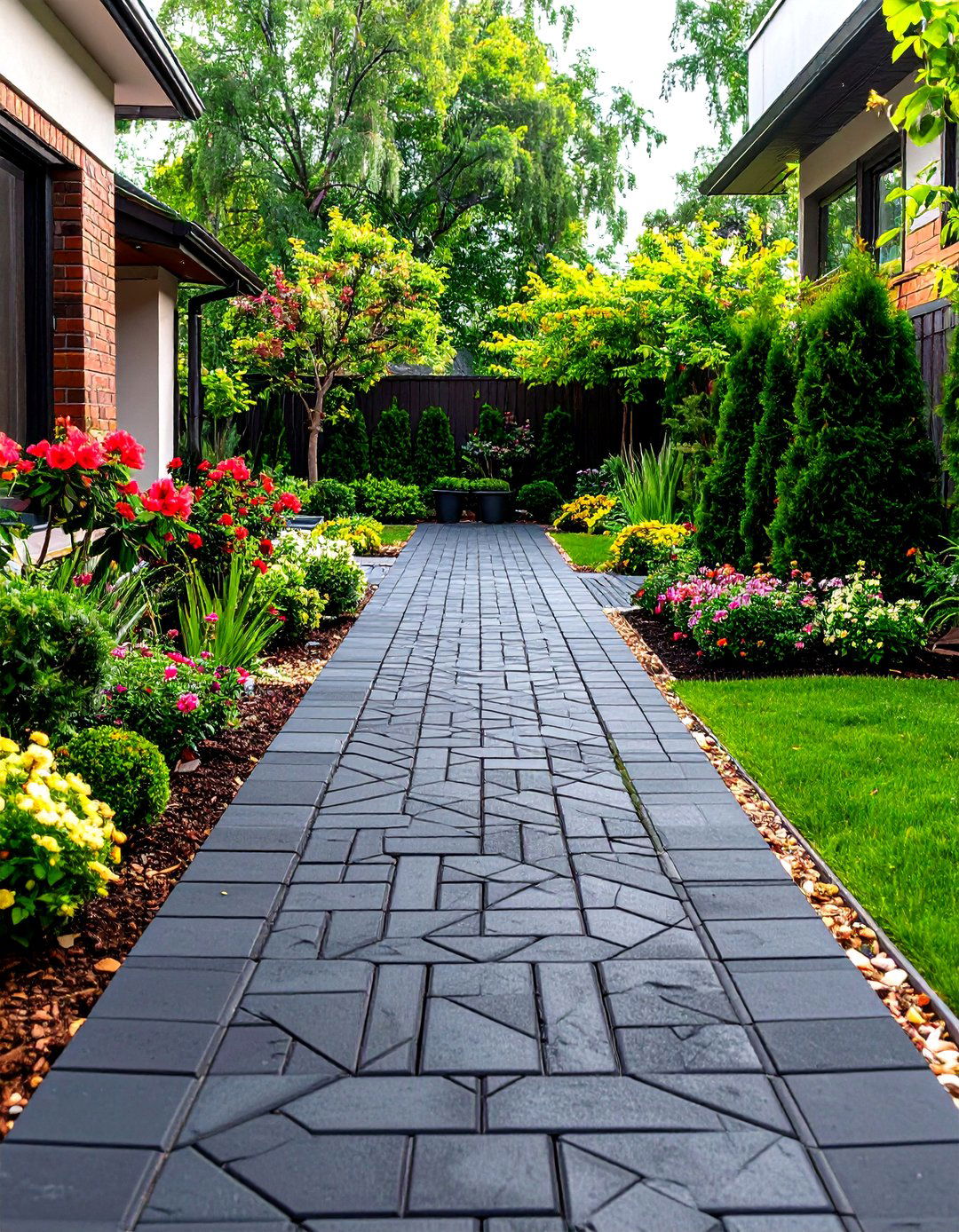
Contemporary geometric patterns push the boundaries of traditional black brick walkway design through innovative arrangements and angular configurations. These designs incorporate squares, diamonds, and chevron patterns that create bold visual statements perfect for modern architectural settings. The stark contrast of black bricks against lighter grout lines or surrounding materials emphasizes the geometric precision, making each pattern element clearly defined and visually striking. Installation involves careful planning and precise cutting to achieve clean lines and perfect angles. This approach works exceptionally well for urban properties and contemporary homes where architectural elements favor clean, structured aesthetics over organic forms.
3. Curved Black Brick Walkway with Natural Flow
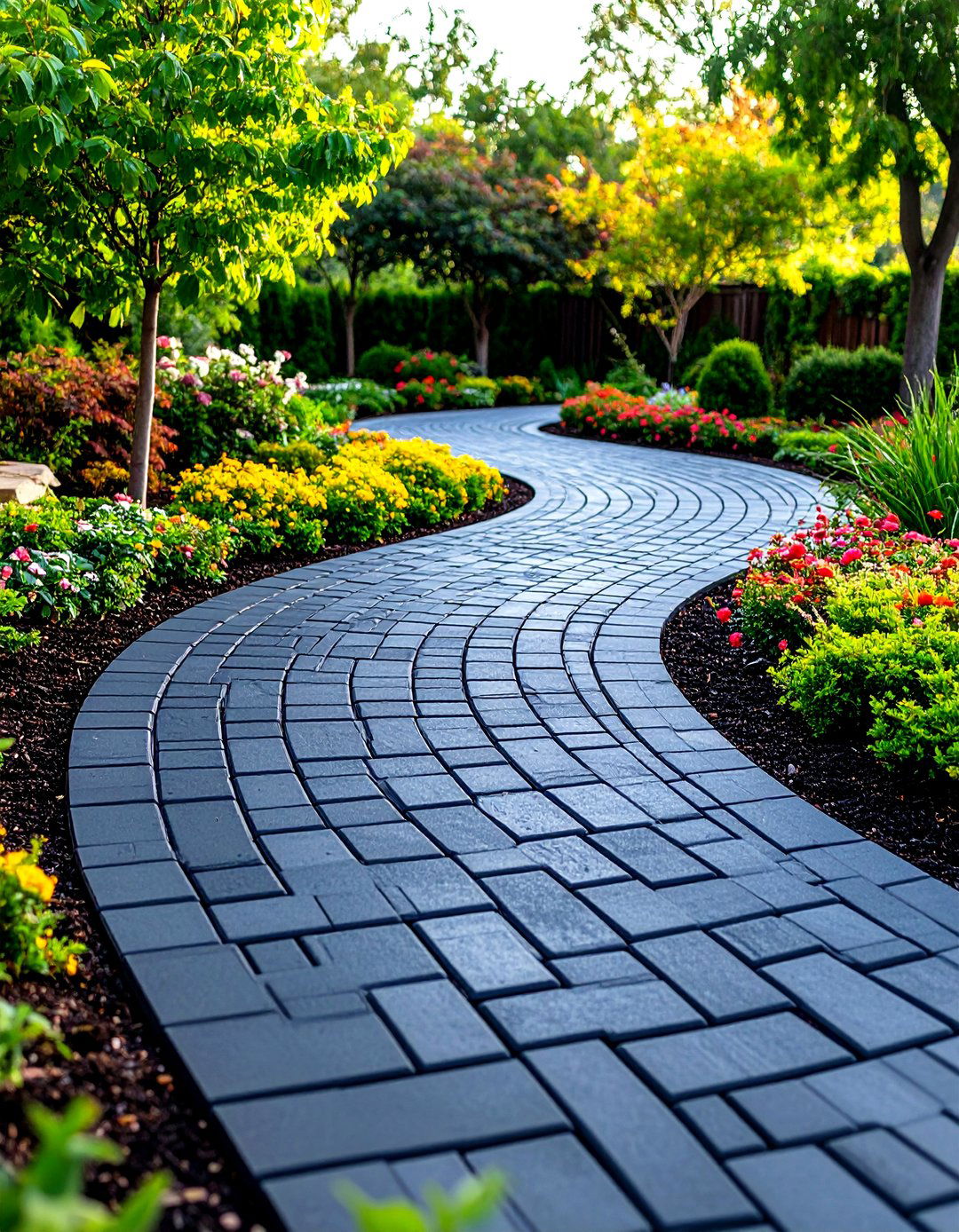
Curved black brick walkways offer an organic alternative to rigid geometric designs, creating gentle pathways that flow naturally through landscape features. The flowing lines soften hard architectural elements while guiding visitors on a meandering journey through garden spaces. Black bricks adapted to curved installations require careful cutting and strategic placement to maintain smooth transitions without awkward gaps or irregular spacing. This design approach works particularly well in residential gardens where the pathway needs to navigate around existing trees, flower beds, or water features. The dark brick color creates dramatic contrast against lush plantings while the curved design adds visual interest and encourages leisurely exploration of outdoor spaces.
4. Black Brick Walkway with Gravel Accent Strips
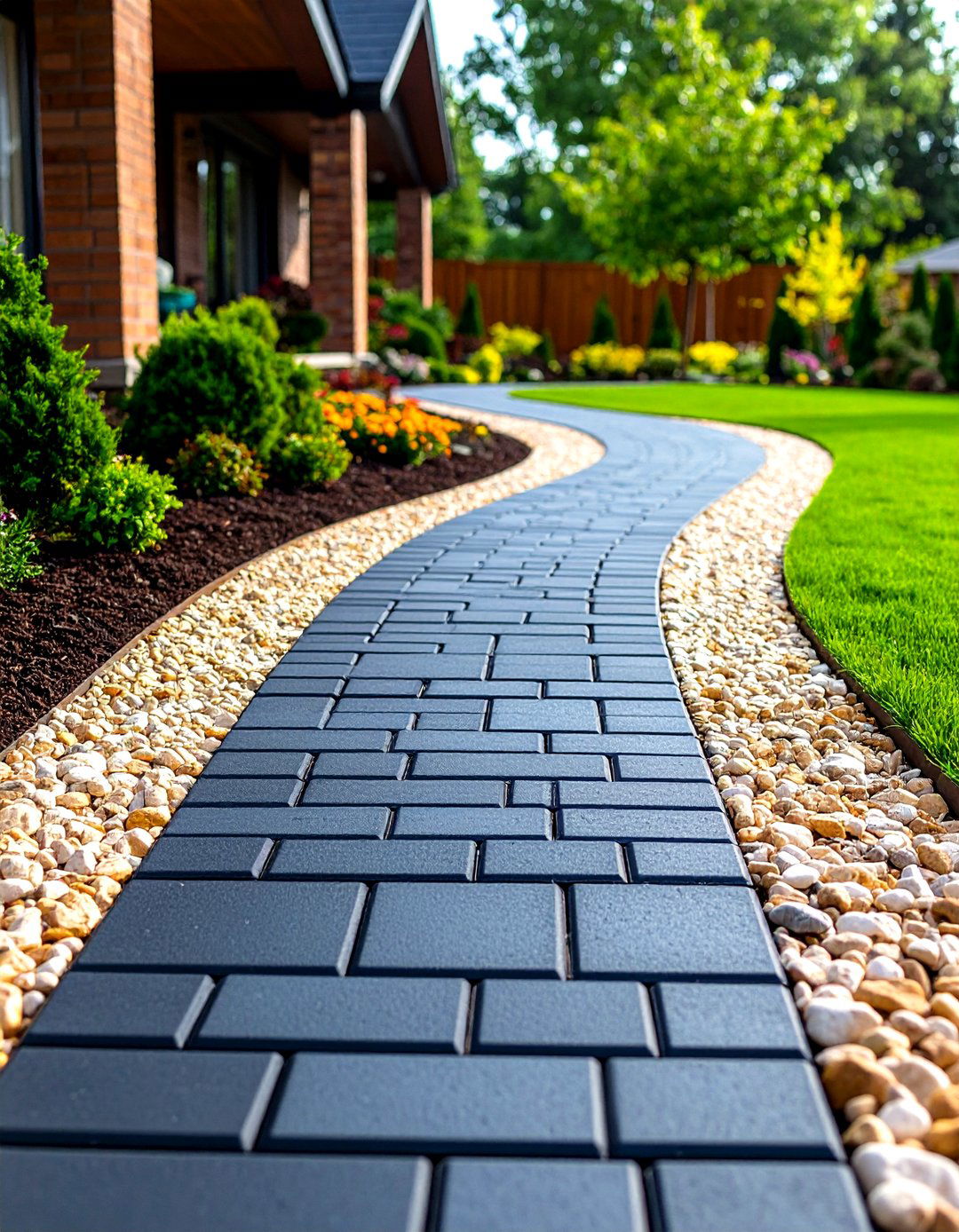
Integrating gravel accent strips into black brick walkway designs creates textural contrast while adding practical drainage benefits. The combination of smooth brick surfaces with coarse gravel textures provides visual variety that keeps walkways interesting and engaging. Light-colored gravel creates striking contrast against dark bricks, while darker gravel options offer subtle texture variation without overwhelming the design. These accent strips can run parallel to the walkway direction or create perpendicular crossing patterns that add geometric interest. Installation involves careful planning to ensure proper drainage and prevent gravel migration into surrounding areas. This design approach works well for contemporary landscapes where mixed materials create sophisticated outdoor environments.
5. Contemporary Stacked Bond Black Brick Walkway
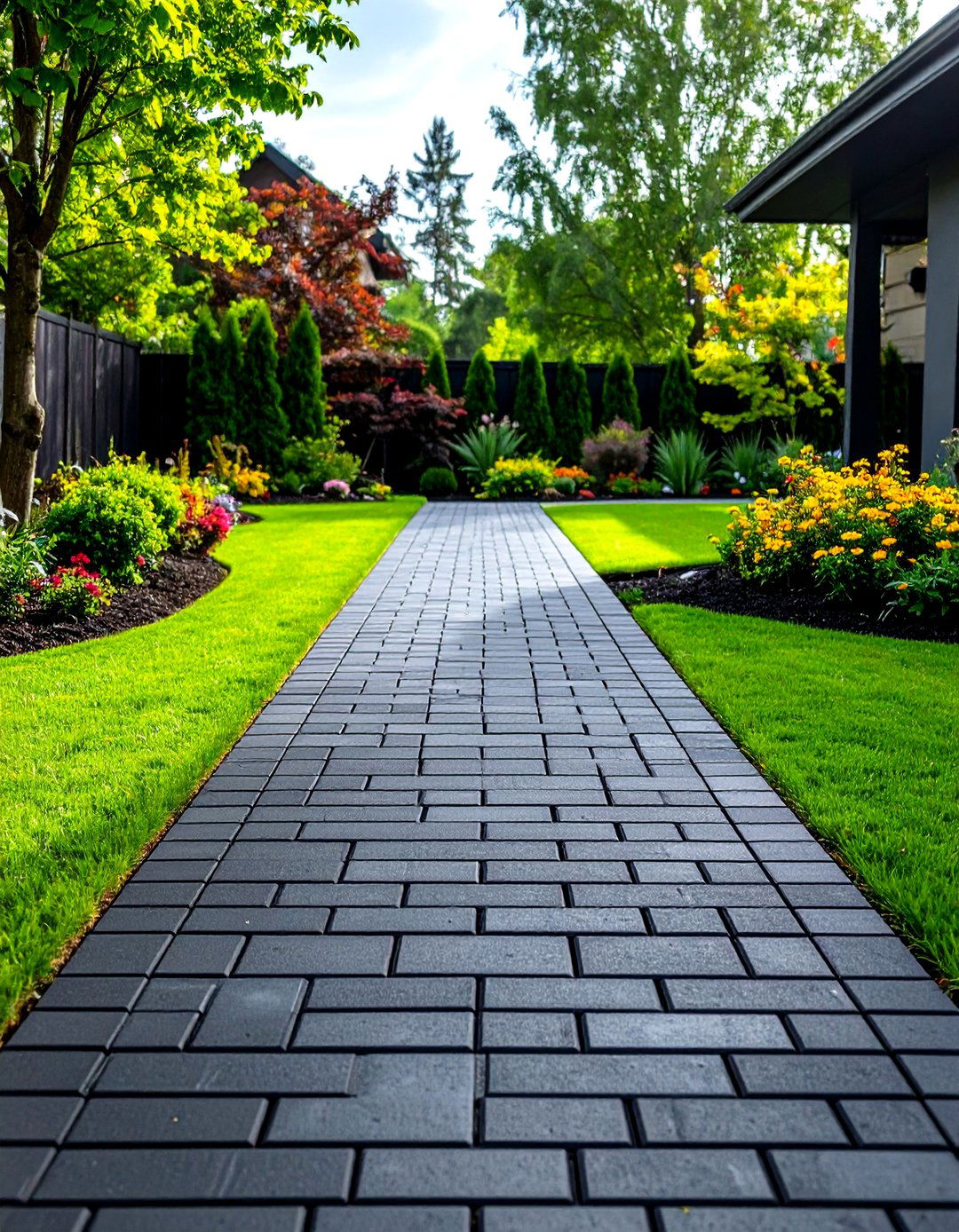
The stacked bond pattern offers a clean, modern approach to black brick walkway design through its streamlined alignment and minimal visual complexity. This pattern features bricks laid directly above one another with aligned vertical joints, creating strong linear elements that complement contemporary architectural styles. The simplicity of stacked bond installations makes them ideal for minimalist garden designs where clean lines and uncluttered aesthetics take precedence. Black bricks in stacked bond configuration create bold, graphic statements that work well as accent pathways or primary entrance routes. Installation is relatively straightforward, making this pattern accessible for both professional installers and ambitious homeowners seeking modern landscape solutions.
6. Traditional Basketweave Black Brick Walkway Pattern
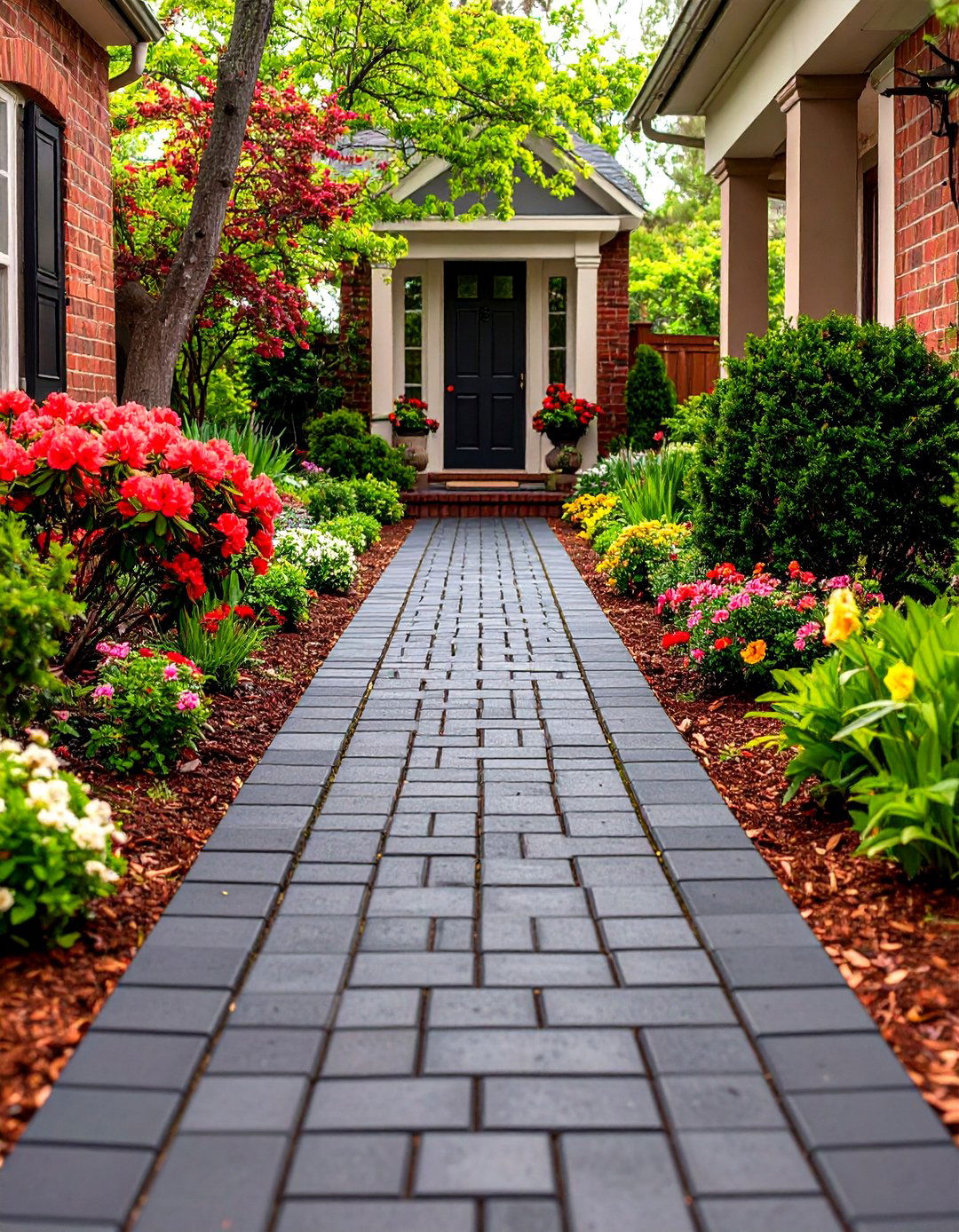
The basketweave pattern brings classic charm to black brick walkway designs through its distinctive woven appearance and historical significance. This traditional layout alternates pairs of bricks in horizontal and vertical orientations, creating a pattern that resembles woven baskets or textile designs. When executed with black bricks, basketweave patterns offer sophisticated elegance that complements both traditional and transitional architectural styles. The pattern's inherent structure provides excellent stability while creating visual interest through its alternating directional elements. Installation requires careful attention to maintain consistent spacing and proper alignment, but the resulting pathway combines functional durability with timeless aesthetic appeal that enhances property value and curb appeal.
7. Black Brick Walkway with LED Lighting Integration

Integrated LED lighting transforms black brick walkways into stunning nighttime features that provide both safety and dramatic visual impact. Recessed lights embedded within the pathway or positioned along edges create subtle illumination that highlights the brick texture and pattern while ensuring safe navigation after dark. The dark brick color absorbs ambient light during the day and reflects integrated lighting beautifully at night, creating warm, inviting pathways perfect for evening entertainment or quiet contemplation. Energy-efficient LED systems offer long-term sustainability while providing consistent, reliable illumination. Installation requires electrical planning and weatherproof fixtures, but the result is a sophisticated landscape feature that extends outdoor living hours and creates memorable nighttime experiences.
8. Mixed Material Black Brick Walkway with Stone Borders
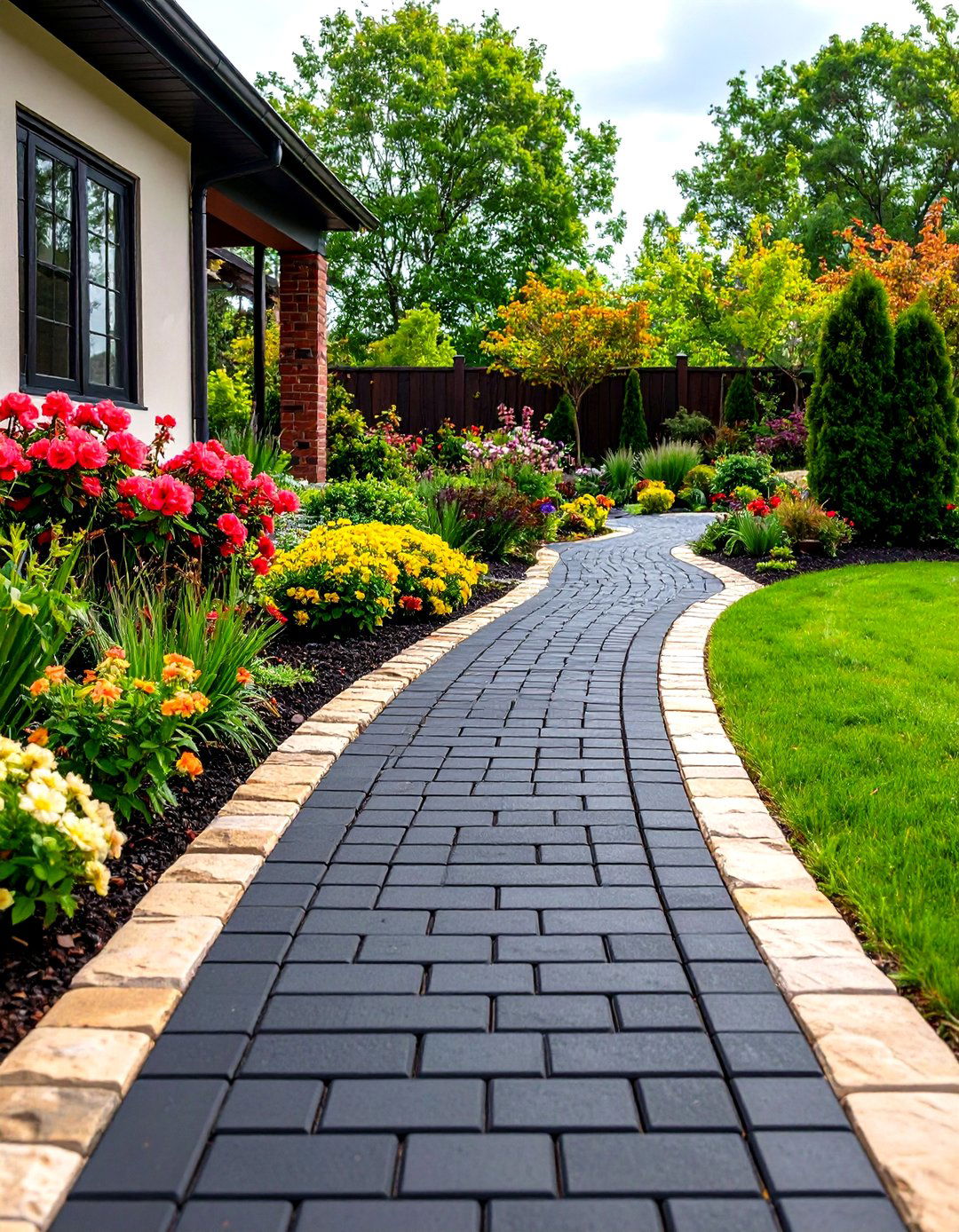
Combining black bricks with natural stone borders creates sophisticated walkways that blend contemporary materials with organic textures. The contrast between manufactured brick uniformity and natural stone irregularity adds visual depth while defining pathway boundaries clearly. Light-colored limestone or granite borders create dramatic contrast against dark bricks, while darker stone options provide subtle texture variation. This design approach allows for creative flexibility in pattern selection while maintaining clean, finished edges that prevent material migration and simplify maintenance. Installation requires careful coordination between different materials but results in durable, visually striking pathways that complement various architectural styles and landscape designs.
9. Diagonal Running Bond Black Brick Walkway
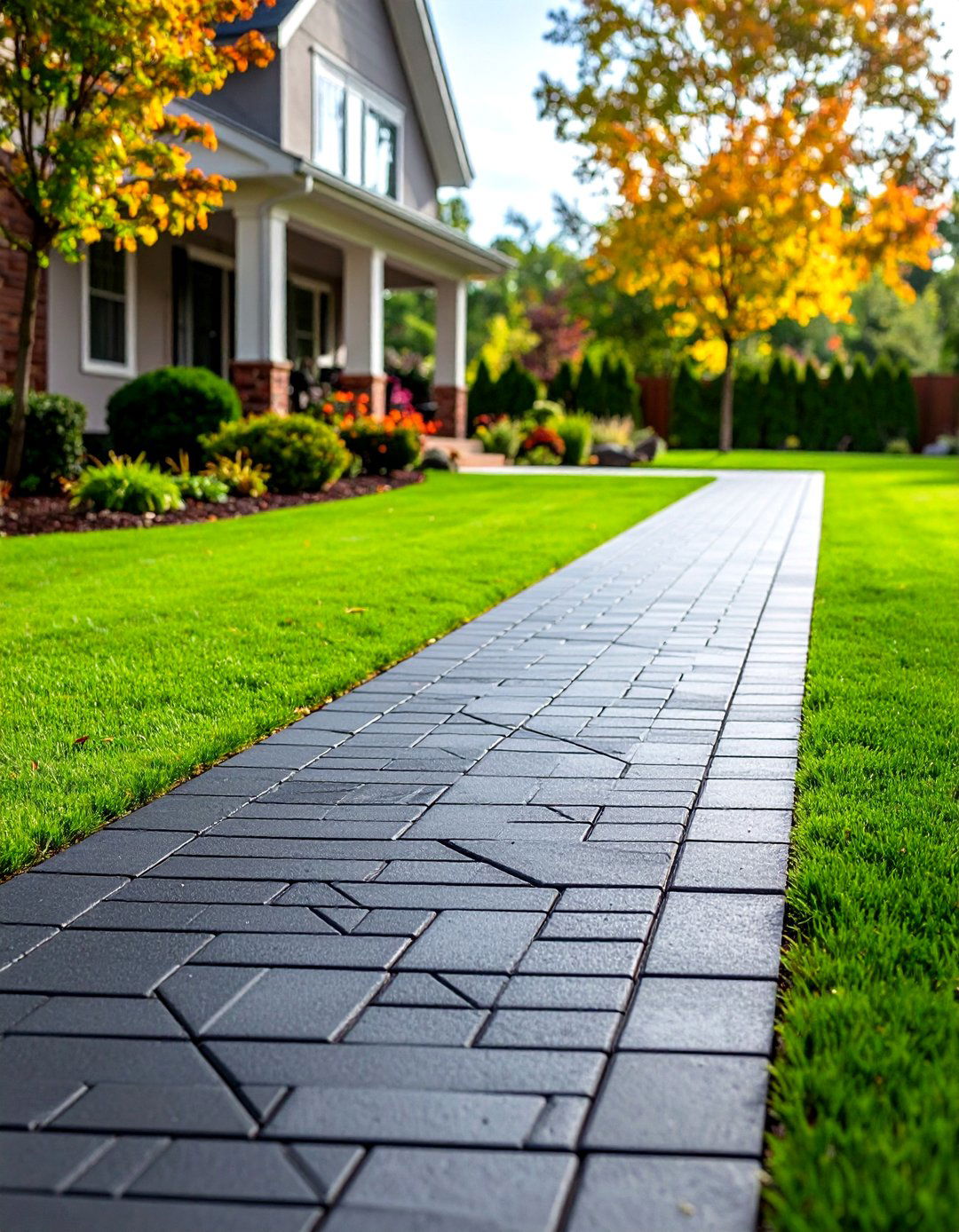
Diagonal running bond patterns create dynamic visual movement in black brick walkways through angled installations that break away from traditional horizontal layouts. This pattern features bricks laid at 45-degree angles, creating diamond-shaped negative spaces that add geometric interest and visual complexity. The diagonal orientation creates illusions of increased width and enhanced movement, making pathways appear more dynamic and engaging. Black bricks in diagonal configurations work well for contemporary landscapes where angular elements complement modern architectural features. Installation requires precise cutting and careful planning to maintain consistent angles, but the result is a distinctive pathway that stands out from conventional designs.
10. Black Brick Walkway with Organic Curved Edging

Organic curved edging softens black brick walkway designs by creating natural transitions between hardscape and landscape elements. Unlike rigid geometric borders, organic edges flow naturally around existing garden features while maintaining the structural integrity of the brick installation. This approach works particularly well for informal garden designs where natural aesthetics take precedence over formal geometry. The contrast between dark brick surfaces and surrounding plantings is enhanced by curved edges that create seamless transitions into garden beds. Installation involves careful excavation and flexible edging materials that can accommodate curved shapes while providing adequate support for the brick surface.
11. Industrial Style Black Brick Walkway with Metal Accents
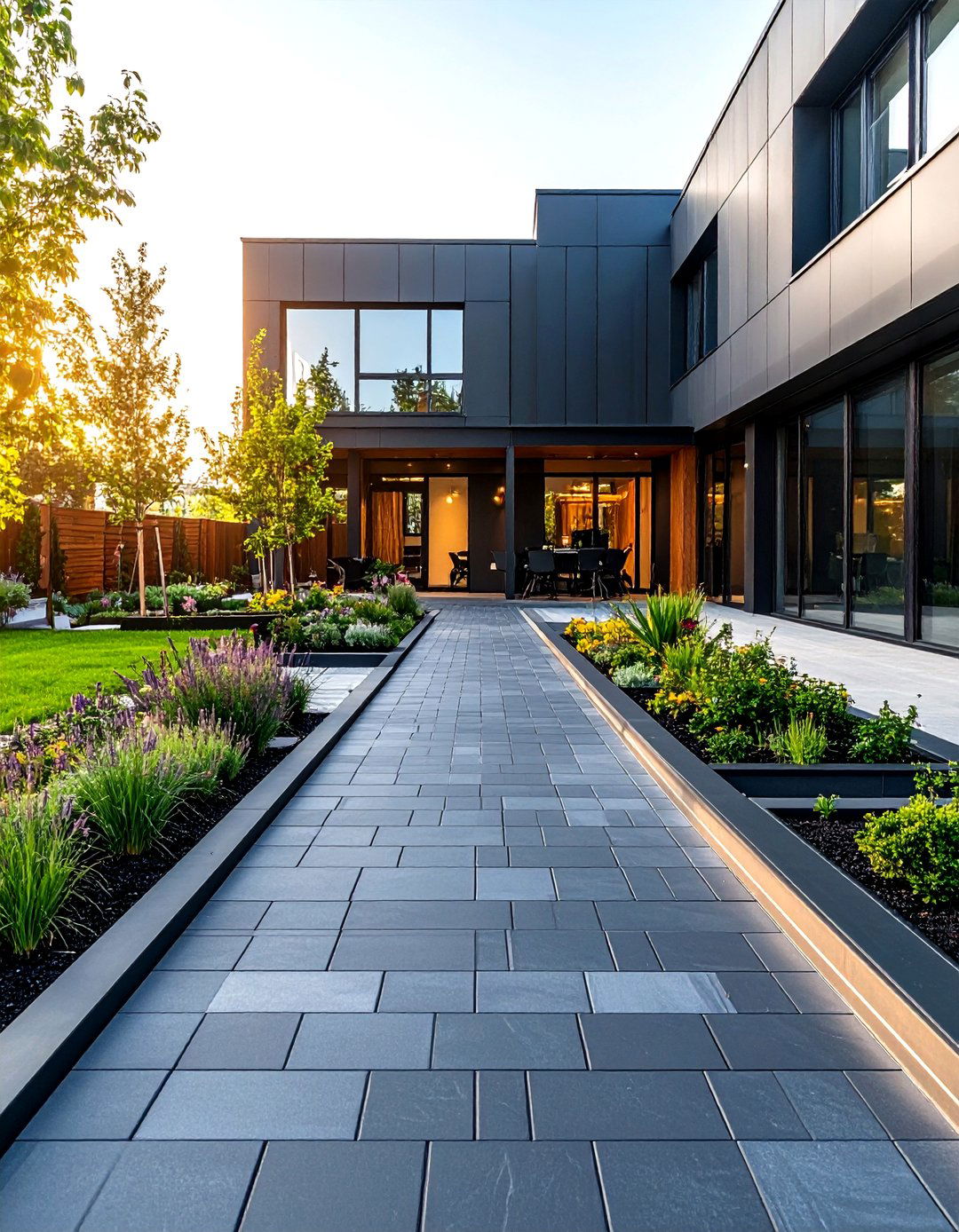
Industrial-style black brick walkways incorporate metal accents and contemporary materials to create bold, urban-inspired outdoor features. Steel or aluminum edging provides clean, modern borders that complement the stark appearance of black bricks while adding structural support and visual definition. This design approach works well for contemporary homes and commercial properties where industrial aesthetics align with architectural themes. Metal accents can include decorative strips, geometric inserts, or functional elements like drainage channels that enhance both form and function. Installation requires coordination between masonry and metalwork but results in durable, striking pathways that make strong design statements.
12. Black Brick Walkway with Soldier Course Borders
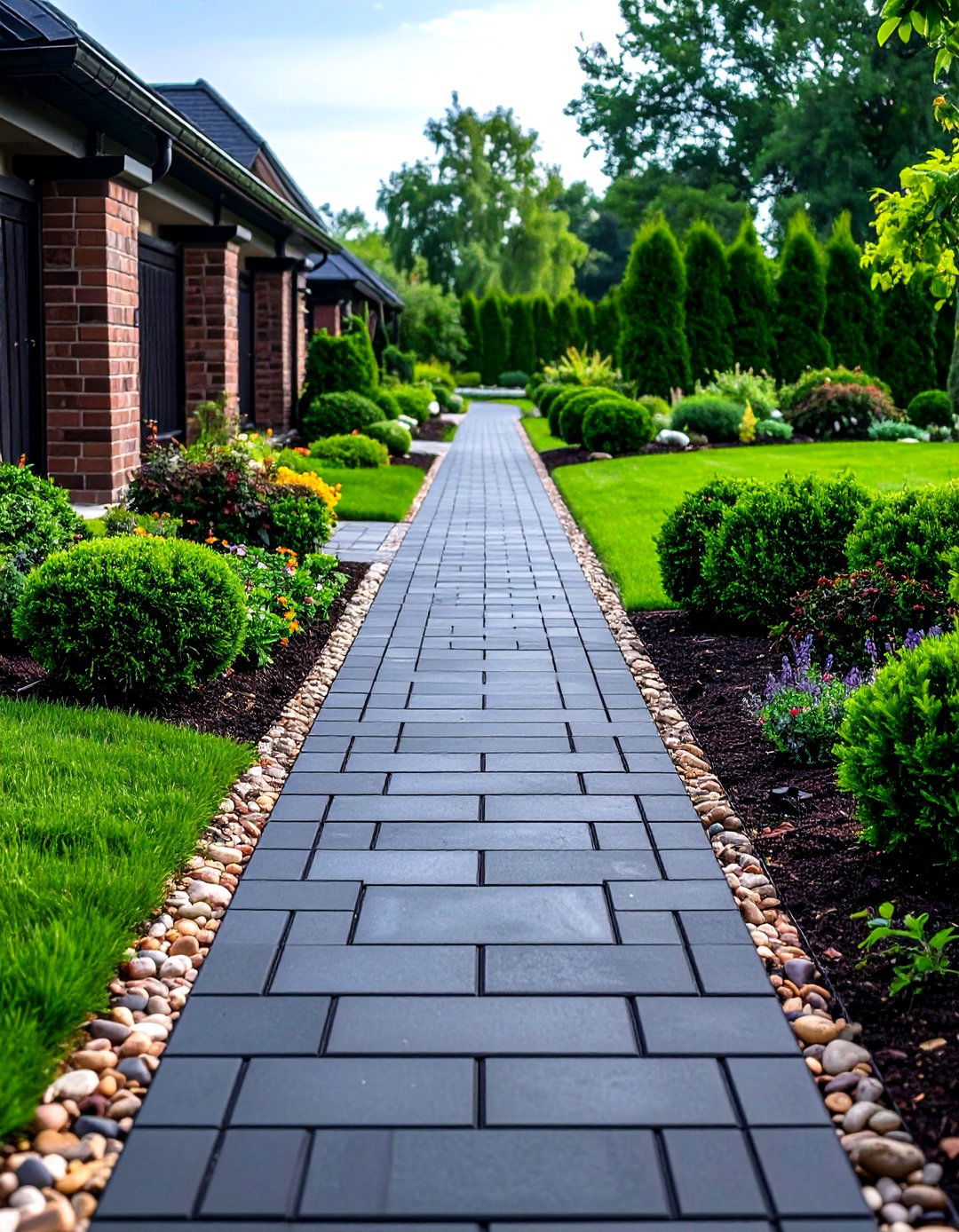
Soldier course borders feature bricks placed vertically on their ends, creating distinctive upright edges that frame black brick walkway surfaces. This traditional technique adds formal elegance while providing clear pathway definition and enhanced visual impact. The vertical orientation of border bricks creates strong linear elements that complement horizontal walkway patterns while adding dimensional interest. Black bricks in soldier course configurations work well for formal landscape designs where structured aesthetics and traditional craftsmanship align with overall design goals. Installation requires careful attention to ensure uniform height and proper foundation support, but the result is a timeless pathway feature that enhances both function and aesthetics.
13. Stepped Black Brick Walkway for Sloped Areas
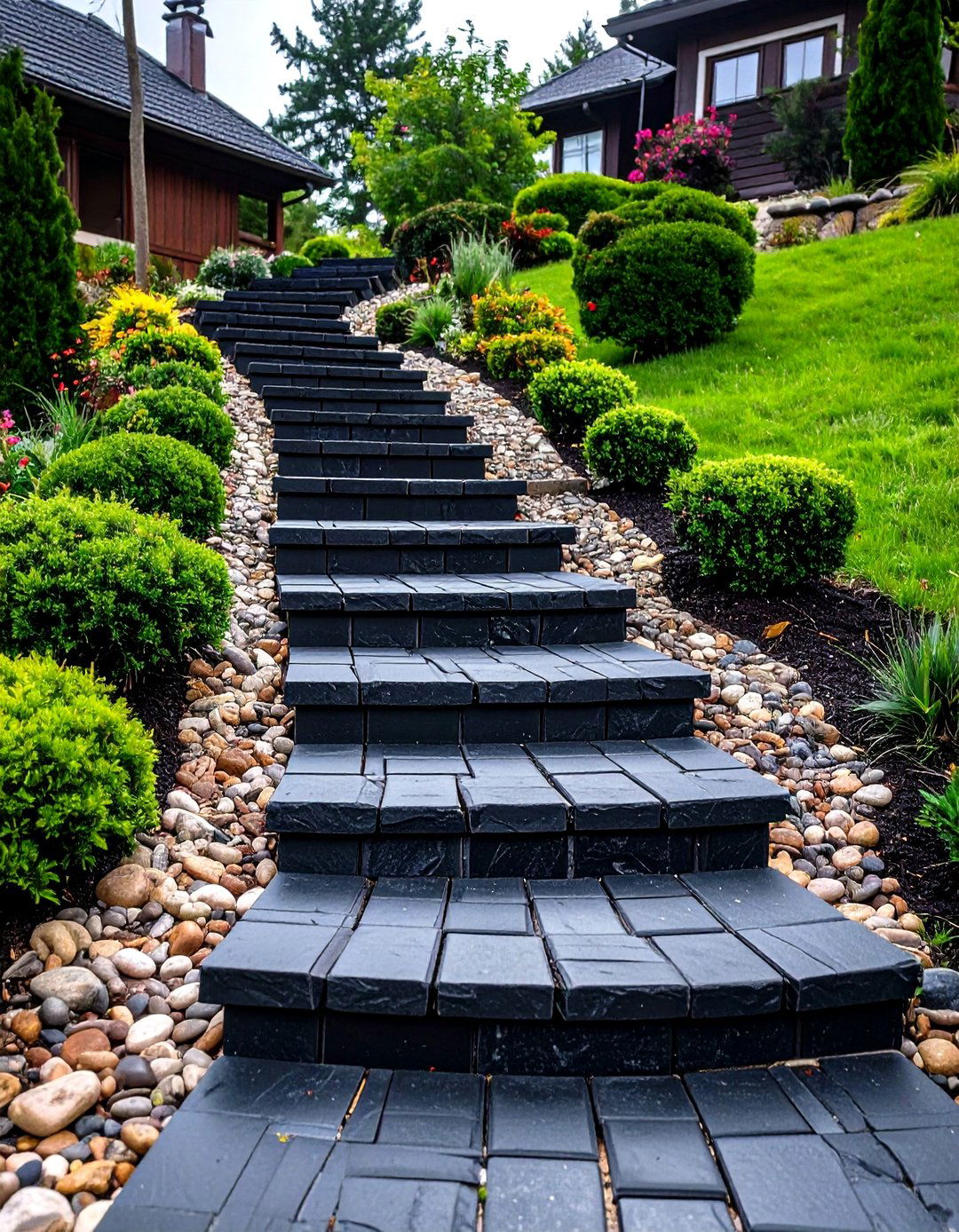
Stepped black brick walkways provide practical solutions for sloped terrain while creating visually interesting transitions between elevation changes. The natural stepping pattern accommodates grade variations while maintaining safe, comfortable navigation for pedestrians. Black bricks in stepped configurations create dramatic shadow lines and geometric patterns that add visual depth to sloped landscapes. This design approach works well for hillside properties and terraced gardens where elevation changes require creative pathway solutions. Installation involves careful grading and structural support to ensure stability and proper drainage, but the result is a functional, attractive pathway that transforms challenging topography into distinctive landscape features.
14. Black Brick Walkway with Integrated Planters
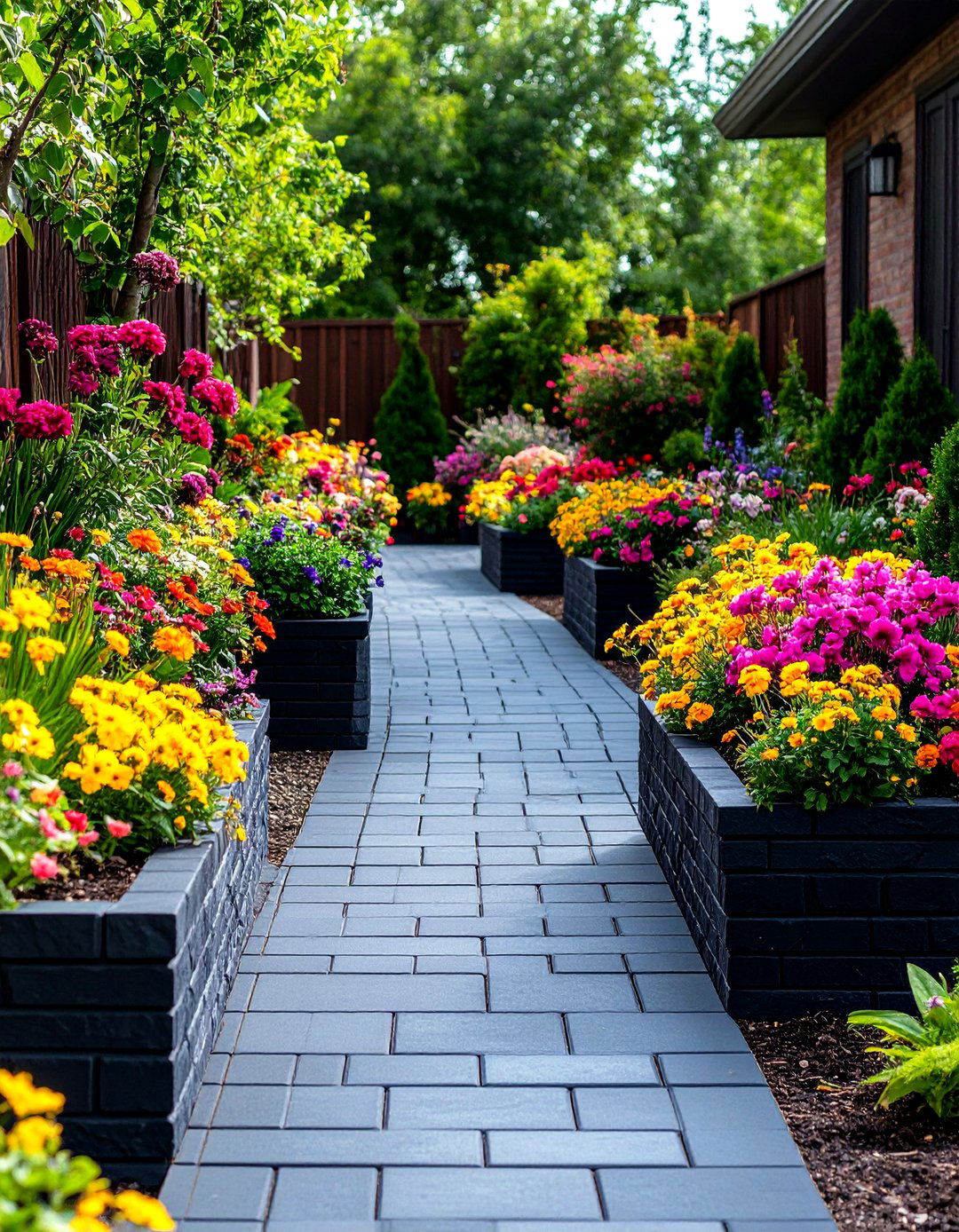
Integrated planters transform black brick walkways into living landscape features that combine hardscape functionality with organic garden elements. These designs incorporate designated planting areas within the walkway structure, allowing for seasonal displays and permanent landscape installations. The contrast between dark brick surfaces and colorful plantings creates dynamic visual interest that changes throughout growing seasons. Strategic plant selection can enhance the walkway's aesthetic appeal while providing fragrance, seasonal color, and habitat for beneficial insects. Installation requires careful drainage planning and appropriate plant selection, but the result is a unique pathway that blends architectural elements with living garden features.
15. Minimalist Linear Black Brick Walkway Design
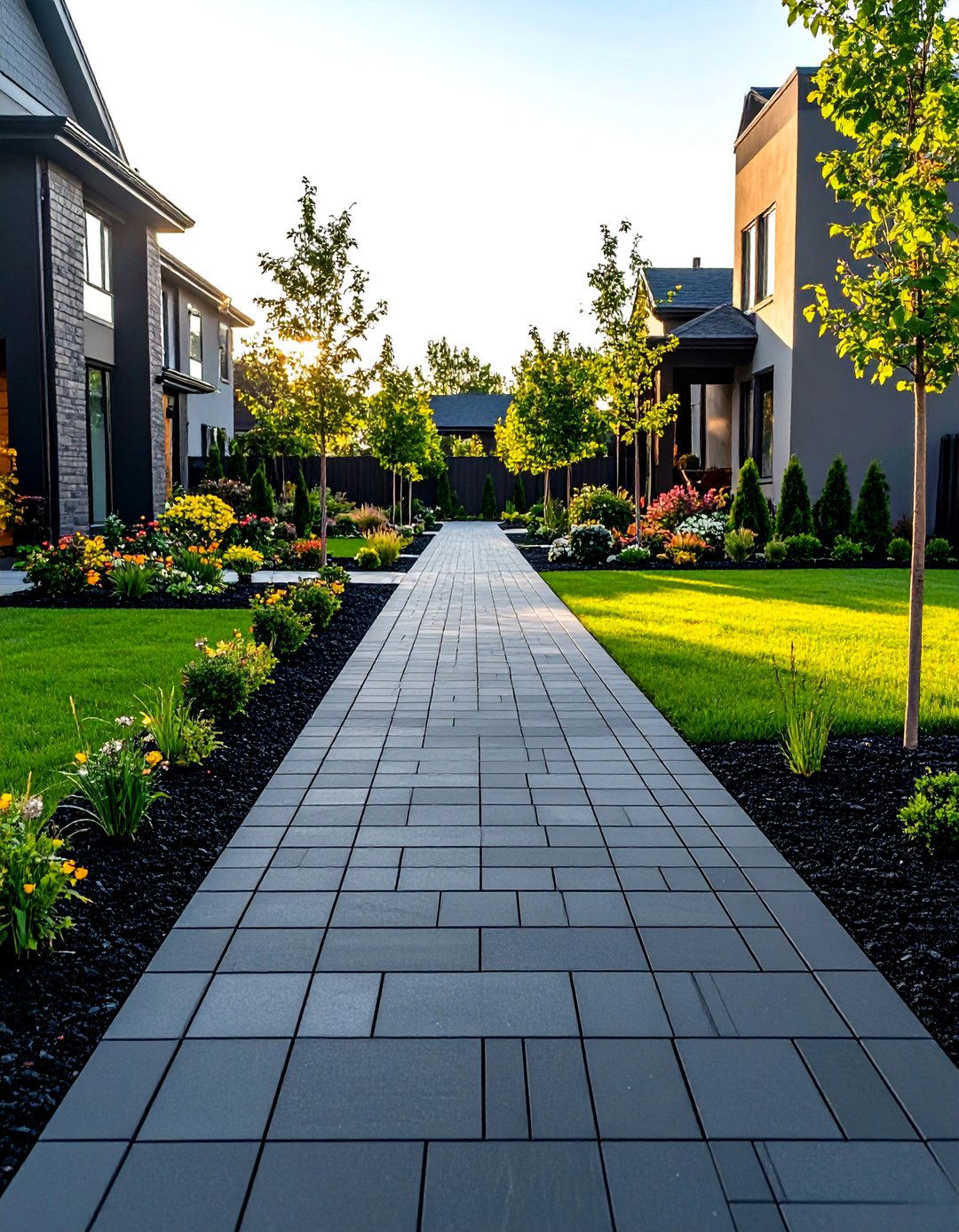
Minimalist linear designs emphasize the inherent beauty of black bricks through clean, unadorned installations that focus on material quality and precise craftsmanship. These pathways feature simple running bond or stacked patterns with minimal decorative elements, allowing the brick texture and color to create visual impact. The stark simplicity of minimalist designs works well for contemporary landscapes where restraint and elegance take precedence over elaborate decoration. Black bricks in linear configurations create strong directional elements that guide movement while maintaining sophisticated aesthetic appeal. Installation focuses on precise alignment and consistent spacing to achieve the clean, uncluttered appearance essential to minimalist design philosophy.
16. Black Brick Walkway with Circular Accent Features
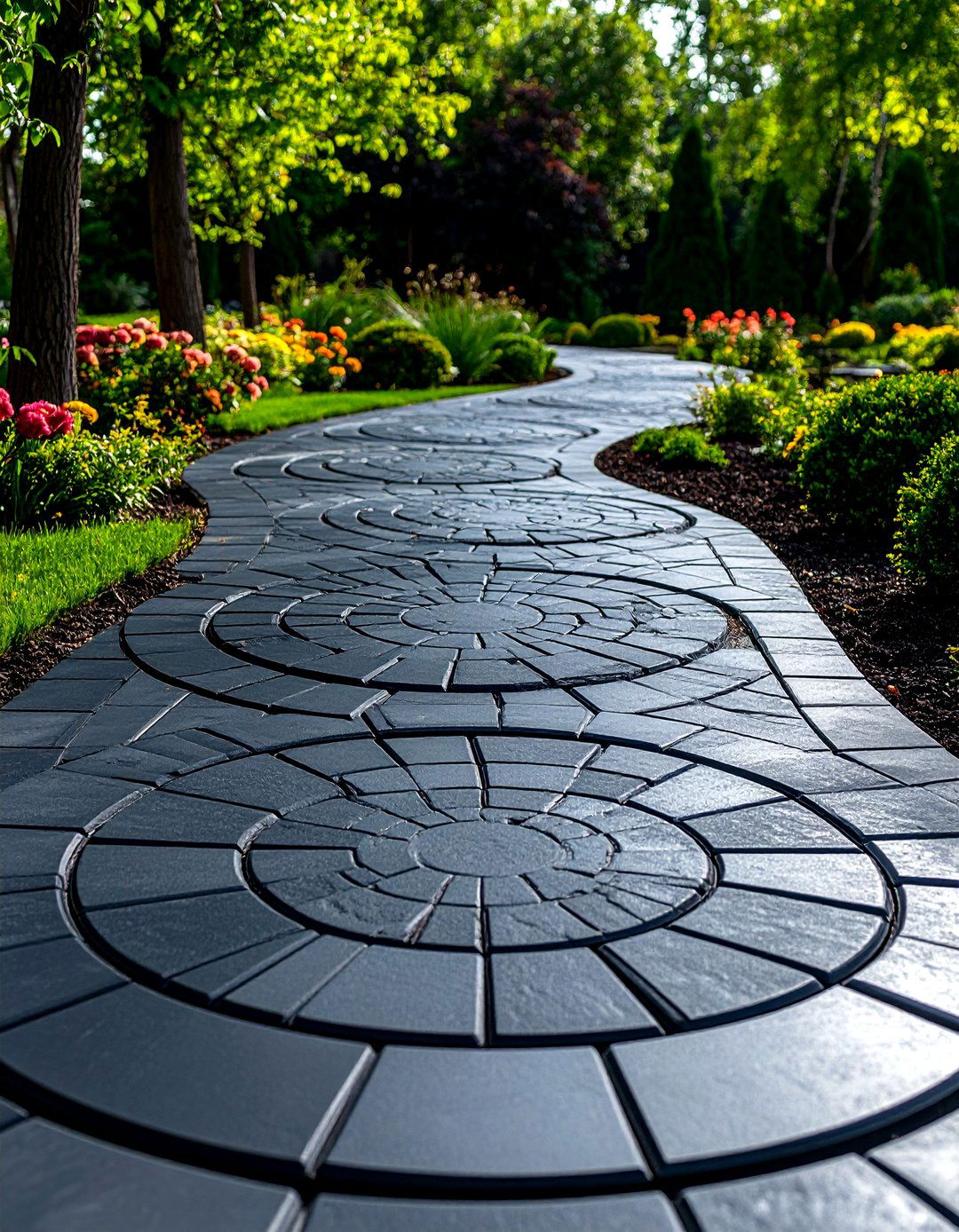
Circular accent features add focal points and visual interest to black brick walkway designs through strategic placement of rounded elements within linear pathways. These accents can include medallions, compass roses, or simple circular patterns that break up long stretches of uniform paving. The geometric contrast between linear walkway elements and circular accents creates dynamic visual tension that enhances overall design impact. Black bricks in circular configurations require precise cutting and careful installation to achieve smooth curves and proper spacing. This design approach works well for formal garden settings where decorative elements enhance the sophisticated character of outdoor spaces.
17. Rustic Weathered Black Brick Walkway Style
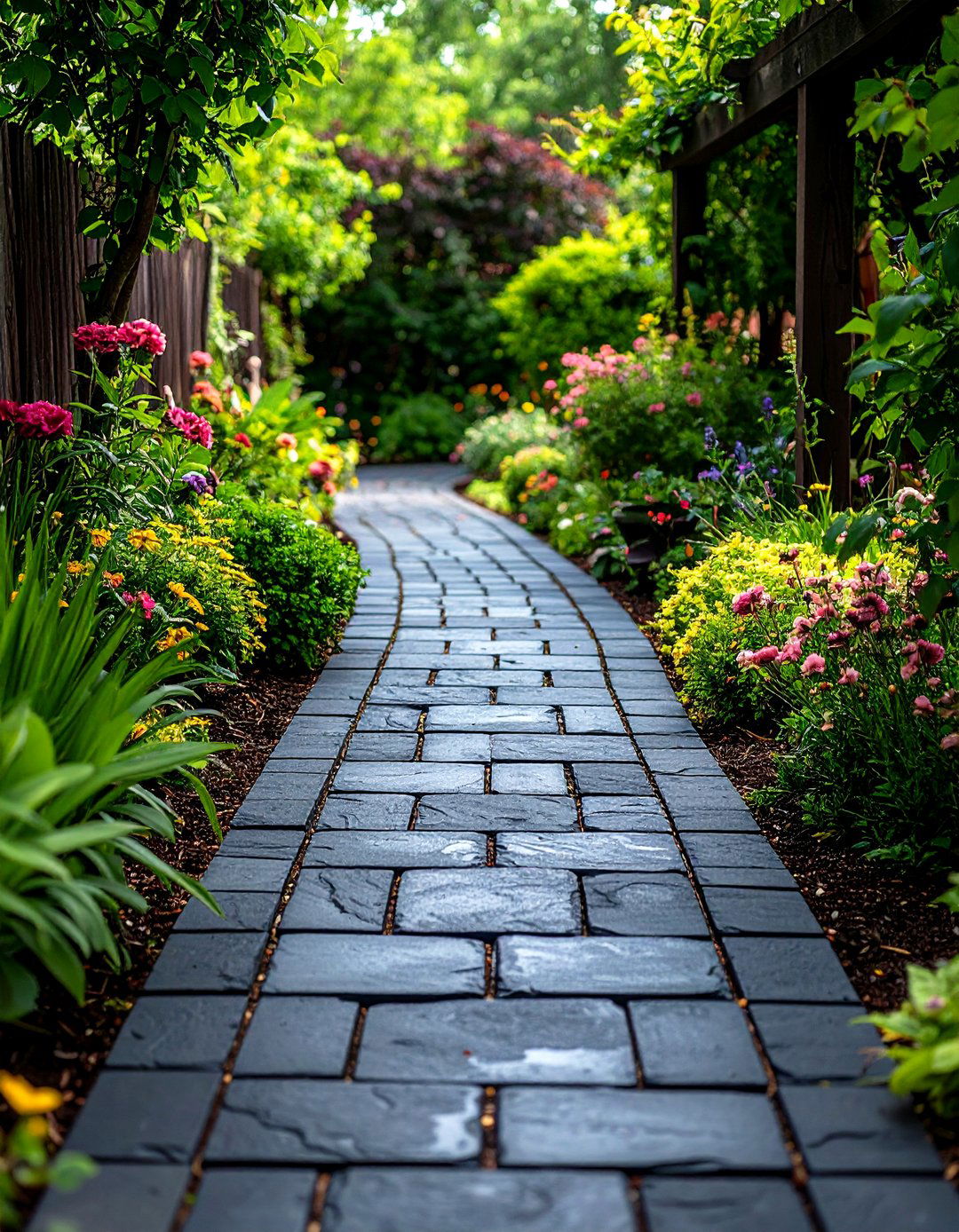
Rustic weathered black brick walkways embrace the natural aging process to create pathways with authentic, time-worn character. This design approach utilizes distressed or naturally aged bricks that show surface variations, edge wear, and color irregularities that suggest decades of weathering. The imperfect beauty of weathered materials creates informal, comfortable pathways that complement cottage gardens and traditional landscape designs. Installation involves selecting appropriate materials and using techniques that enhance rather than conceal natural variations. The result is a pathway that appears to have evolved naturally over time, adding instant maturity and character to new landscape installations.
18. Black Brick Walkway with Contrasting Light Edging
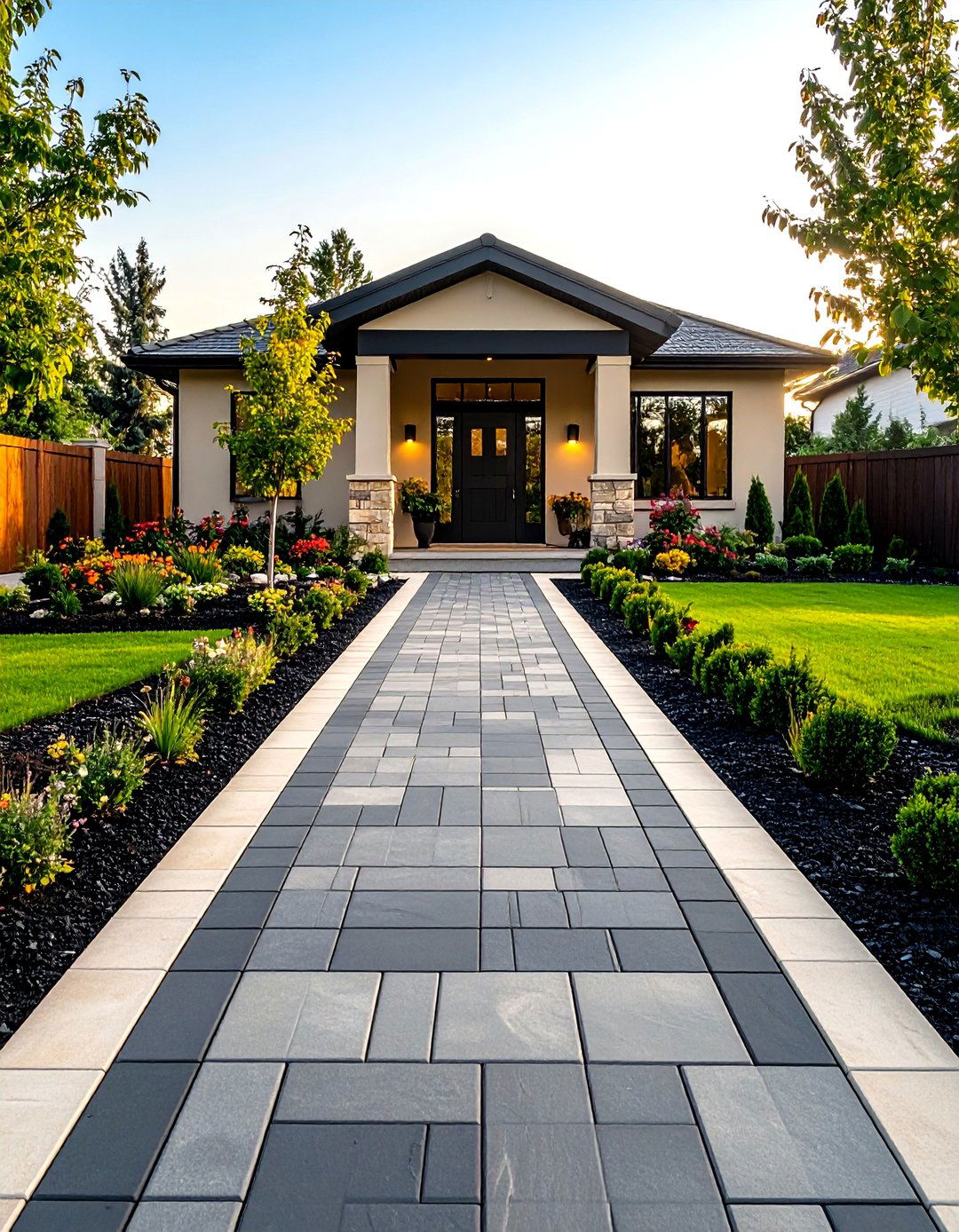
Contrasting light edging creates dramatic visual definition in black brick walkway designs through strategic use of light-colored border materials. White or cream-colored stone, concrete, or brick edging provides stark contrast that emphasizes pathway boundaries while adding sophisticated geometric elements. This high-contrast approach works well for contemporary landscapes where bold design statements align with modern architectural features. The sharp definition created by contrasting materials helps pathway navigation while creating clean, professional appearances that enhance property values. Installation requires careful material selection and precise alignment to achieve the crisp, clean edges essential to this design approach.
19. Spiral Pattern Black Brick Walkway Design
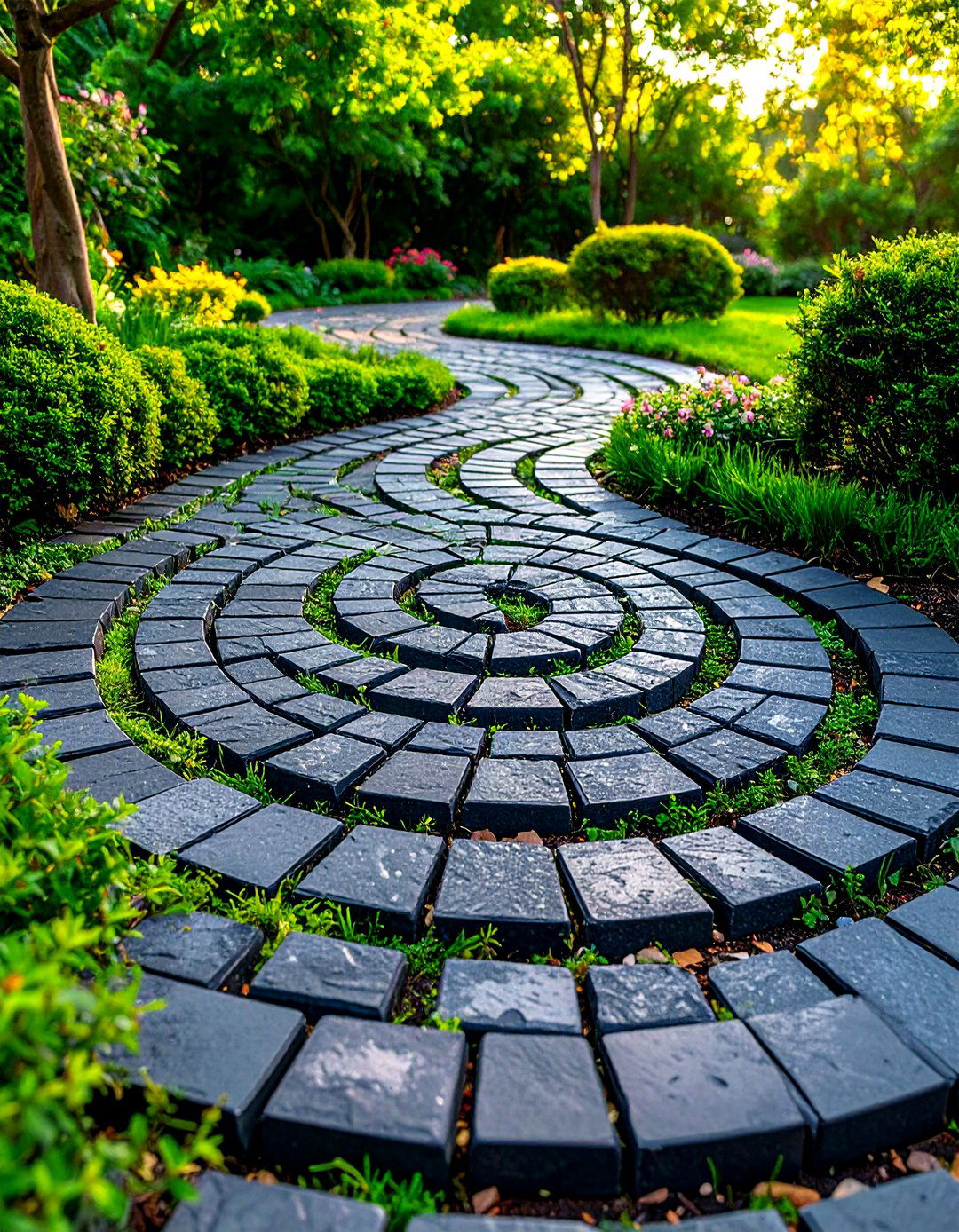
Spiral pattern black brick walkways create unique focal points through curved installations that lead visitors on circular journeys through garden spaces. These designs work well for meditation gardens, memorial spaces, or areas where contemplative movement enhances the landscape experience. The continuous curve of spiral patterns creates visual flow while providing opportunities for strategic plant placement and seasonal displays. Black bricks in spiral configurations require expert cutting and installation to maintain smooth curves and consistent spacing throughout the pattern. This design approach creates distinctive landscape features that serve as both functional pathways and artistic installations.
20. Black Brick Walkway with Sustainable Drainage Features
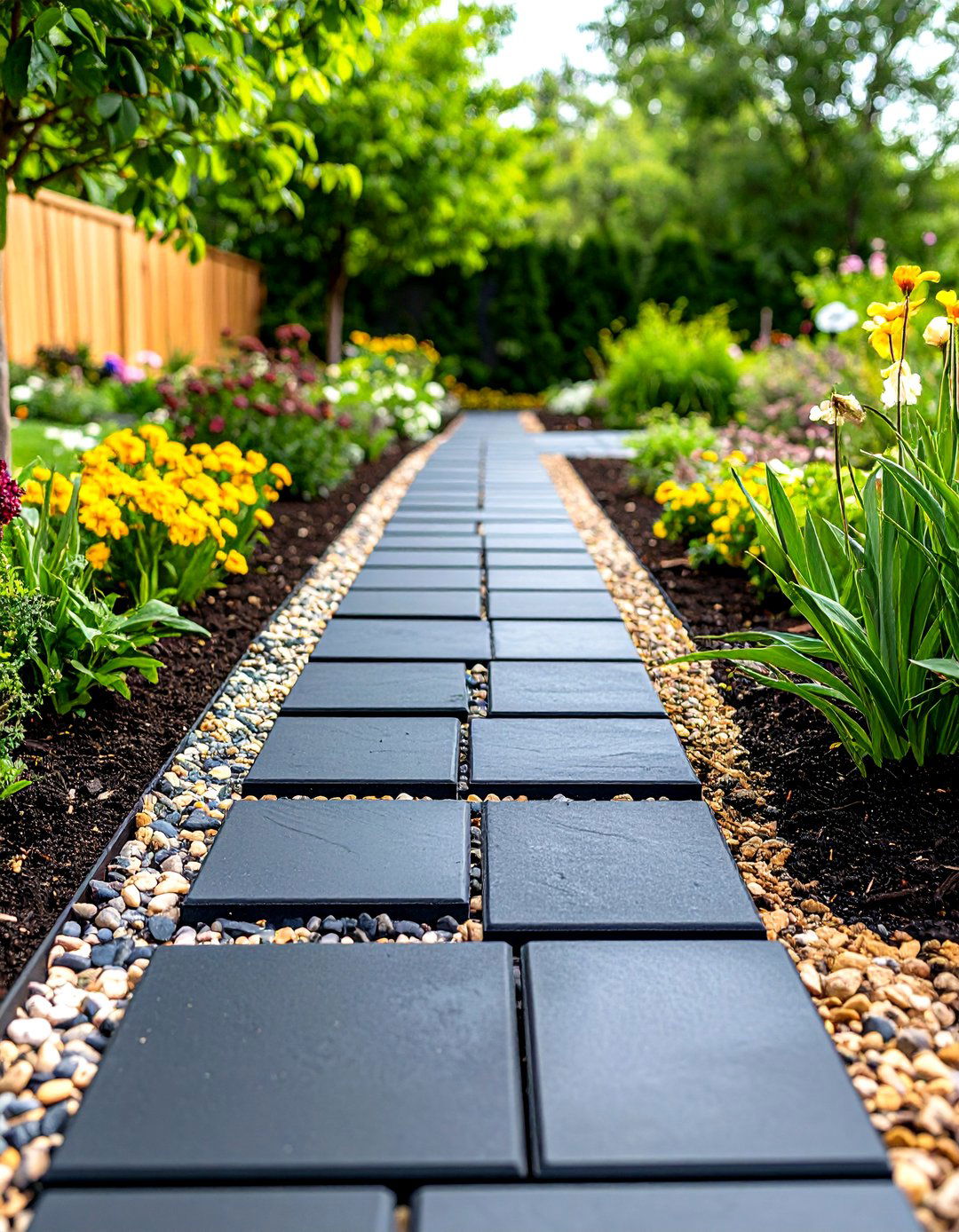
Sustainable drainage features integrate environmental responsibility into black brick walkway designs through permeable installations and strategic water management. These systems incorporate gaps between bricks or underlying drainage layers that allow rainwater infiltration while maintaining surface stability. The environmental benefits include reduced stormwater runoff, groundwater recharge, and decreased strain on municipal drainage systems. Black bricks in permeable configurations provide attractive, functional surfaces that support sustainable landscape practices without compromising aesthetic appeal. Installation requires specialized techniques and appropriate base materials, but the result is an environmentally responsible pathway that demonstrates commitment to sustainable design practices while maintaining beautiful, durable outdoor surfaces.
Conclusion:
Black brick walkways offer unparalleled versatility for creating stunning outdoor pathways that combine durability with sophisticated aesthetics. From classic herringbone patterns to contemporary geometric designs, these twenty ideas demonstrate the creative potential of black brick installations. Whether incorporating sustainable drainage features, integrated lighting, or mixed materials, each approach provides unique solutions for specific landscape challenges. The timeless appeal of black bricks ensures these pathways will remain attractive and functional for decades while requiring minimal maintenance. By selecting appropriate patterns and complementary features, homeowners can create distinctive walkways that enhance property value and provide lasting outdoor enjoyment.


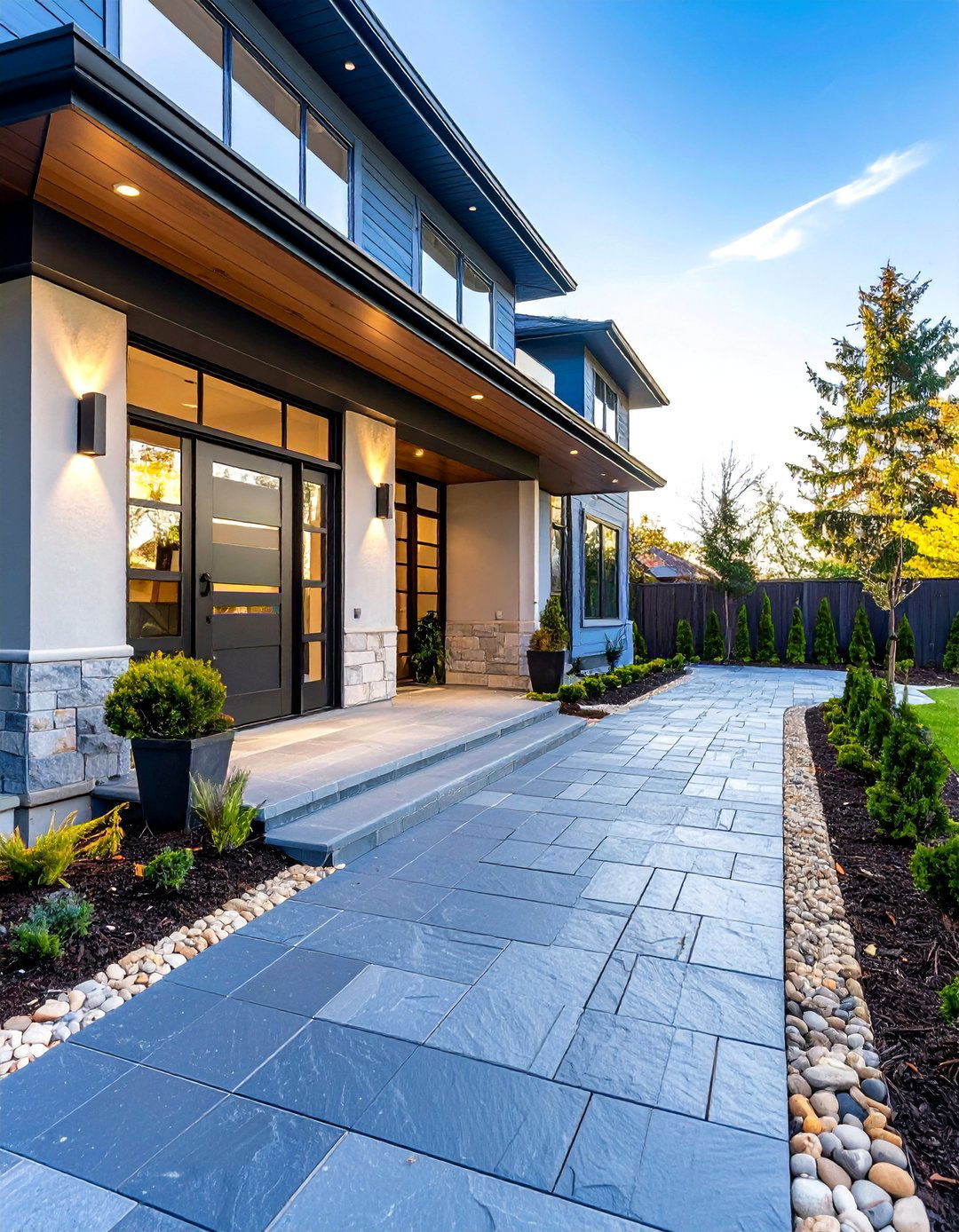

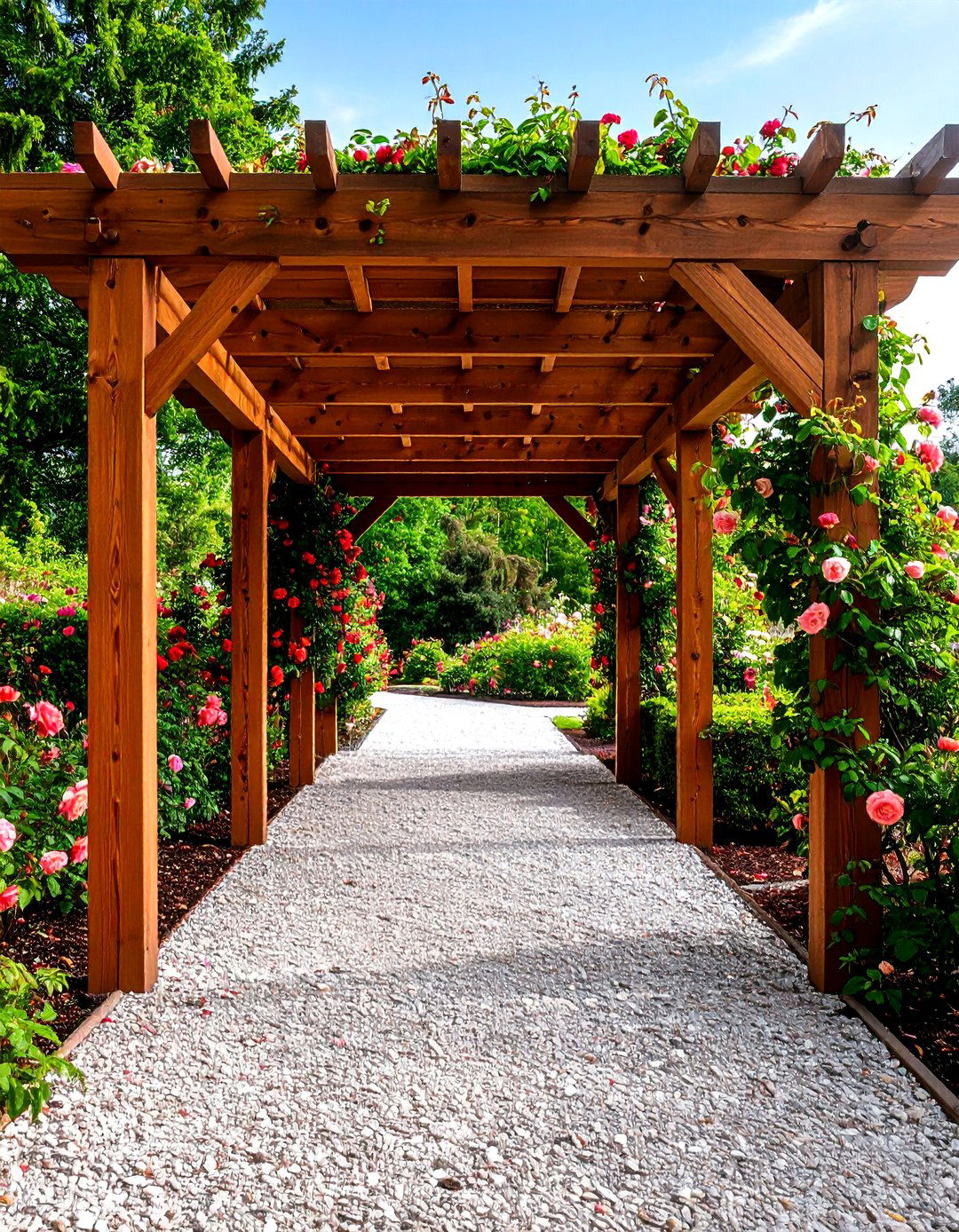
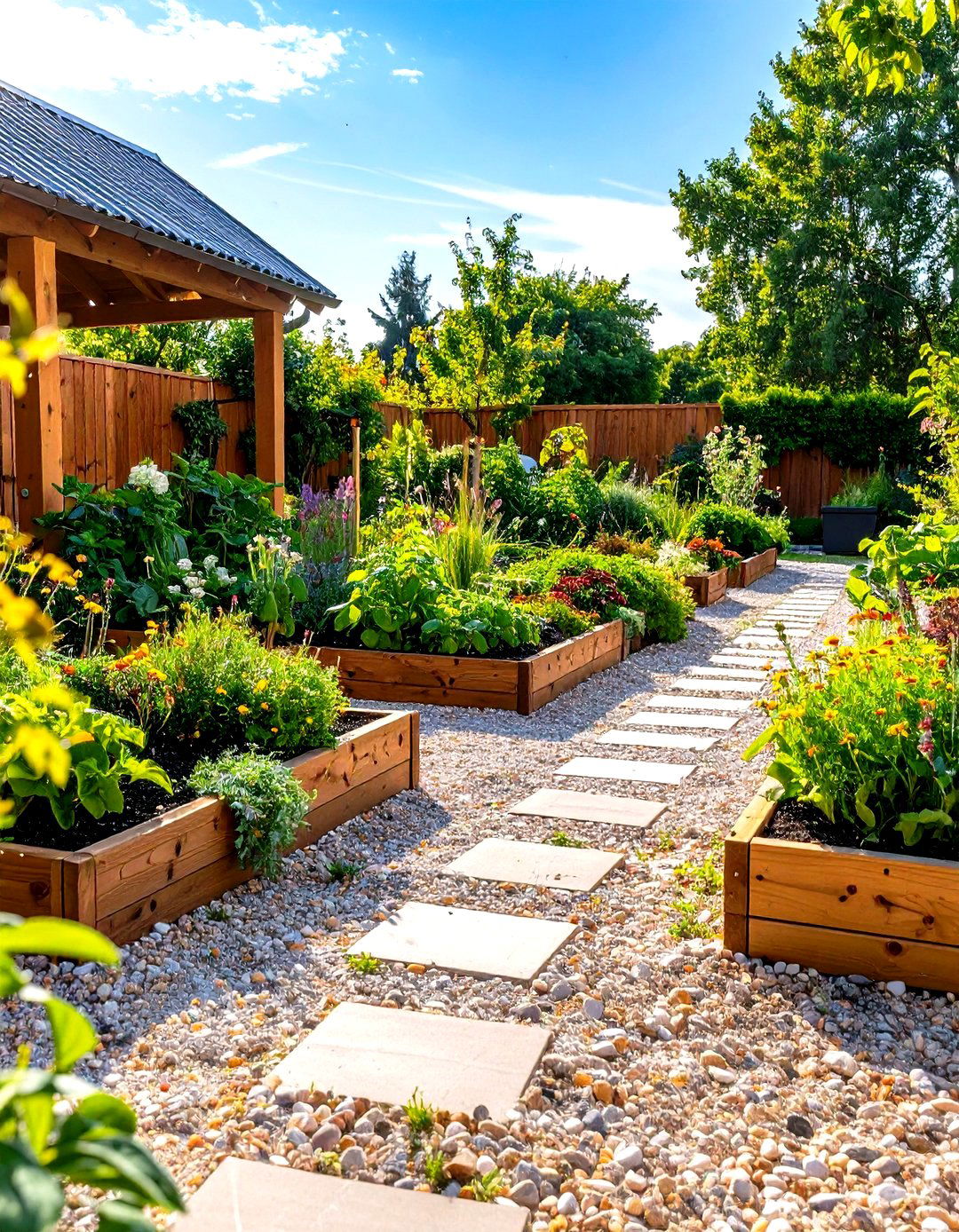
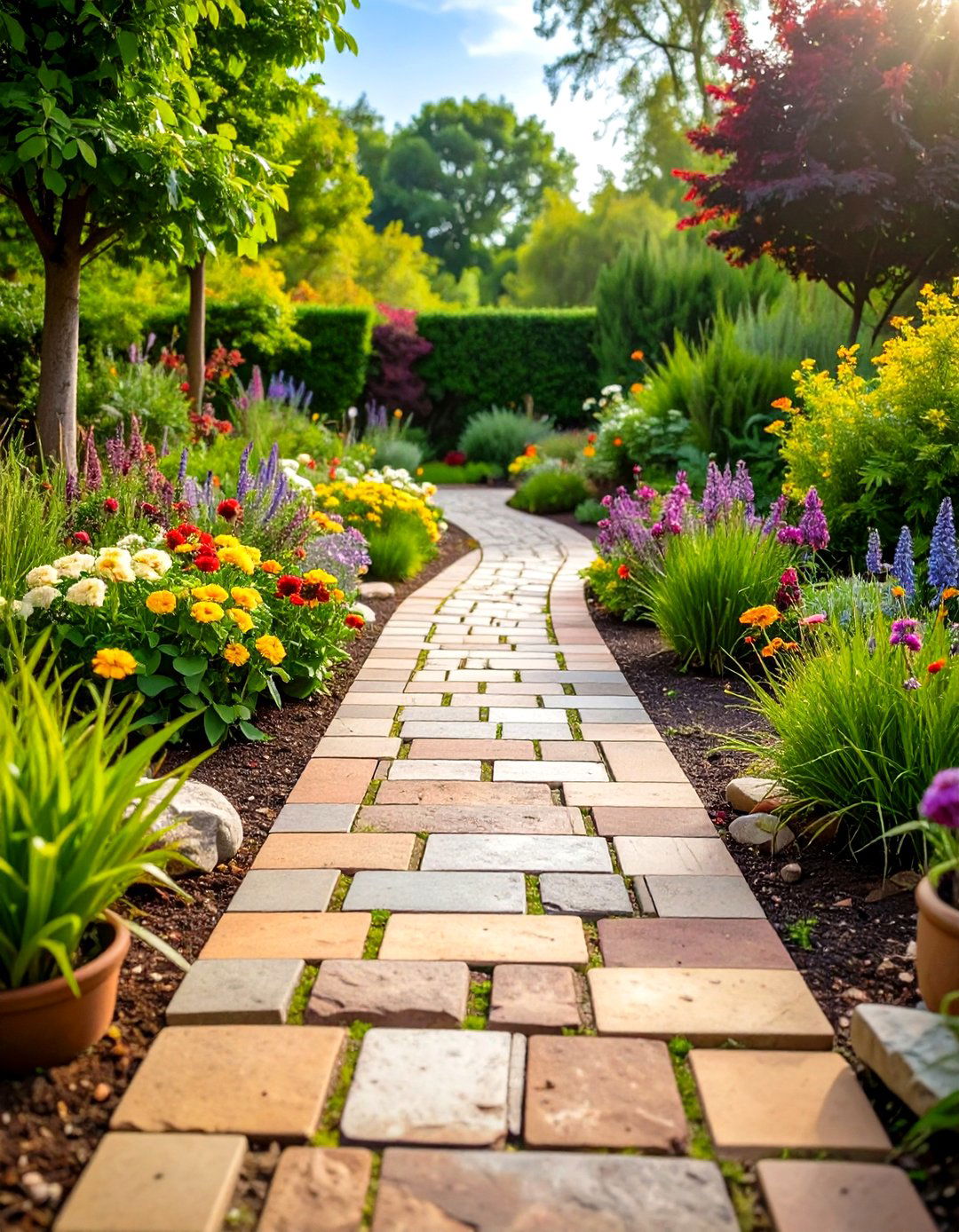
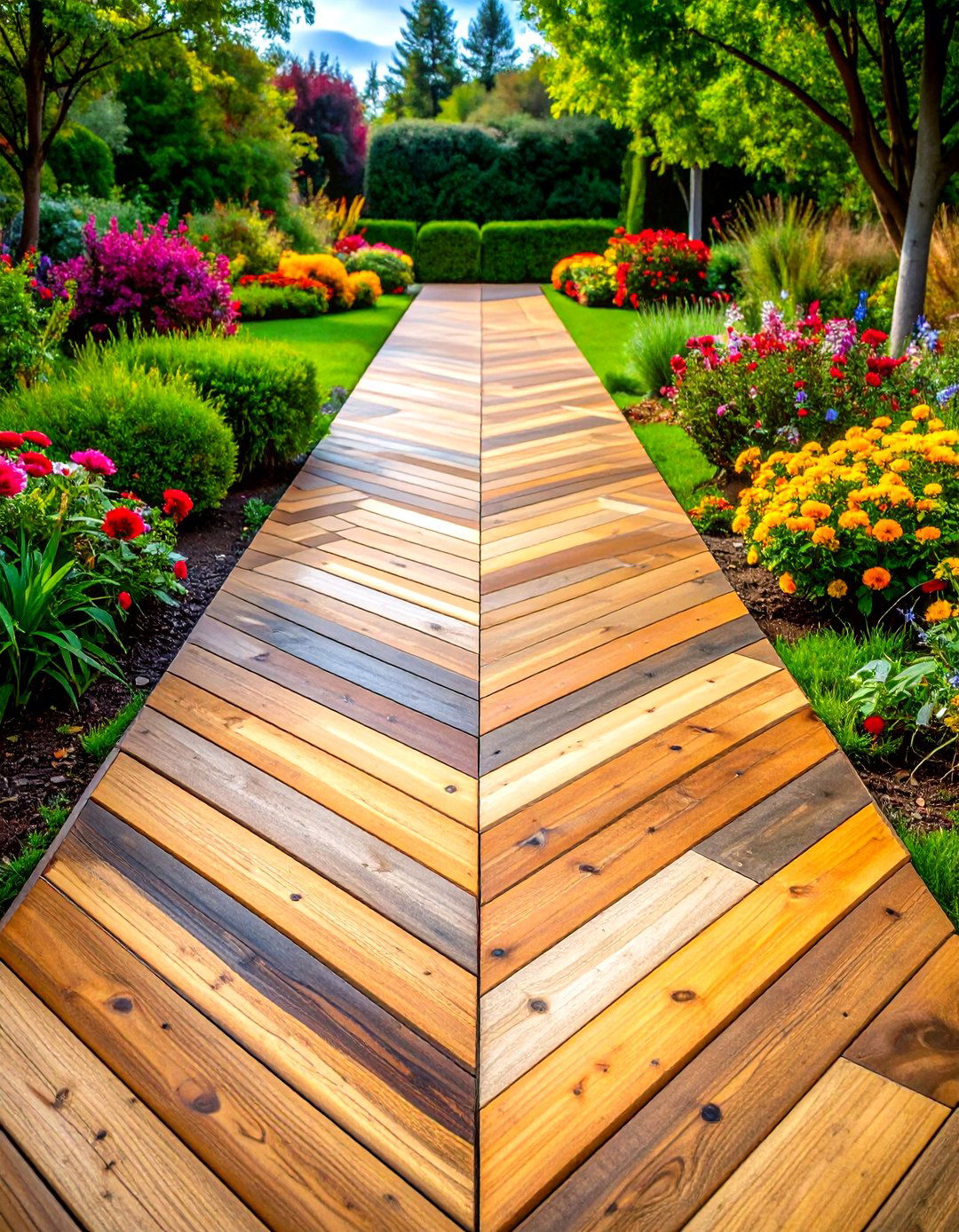

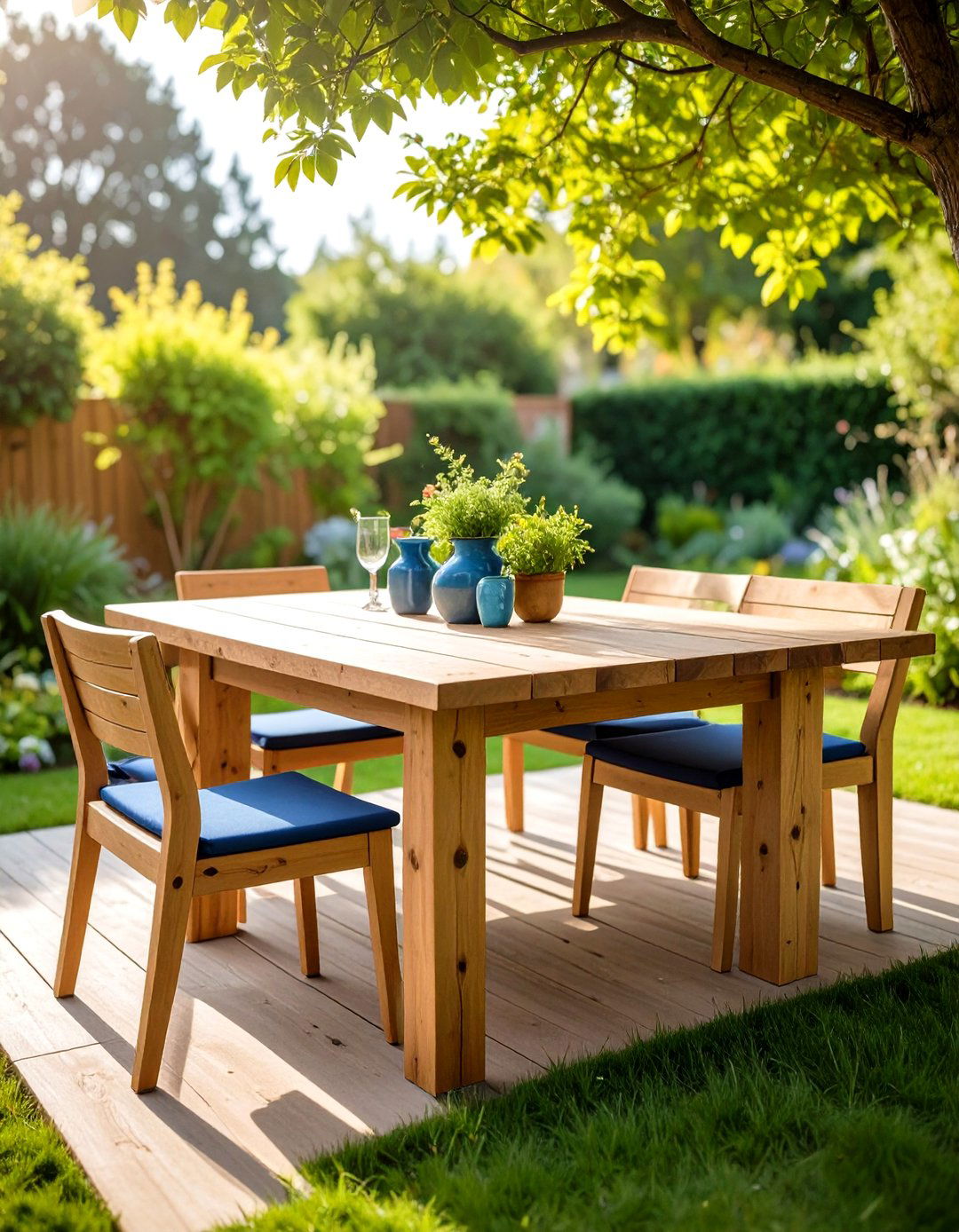
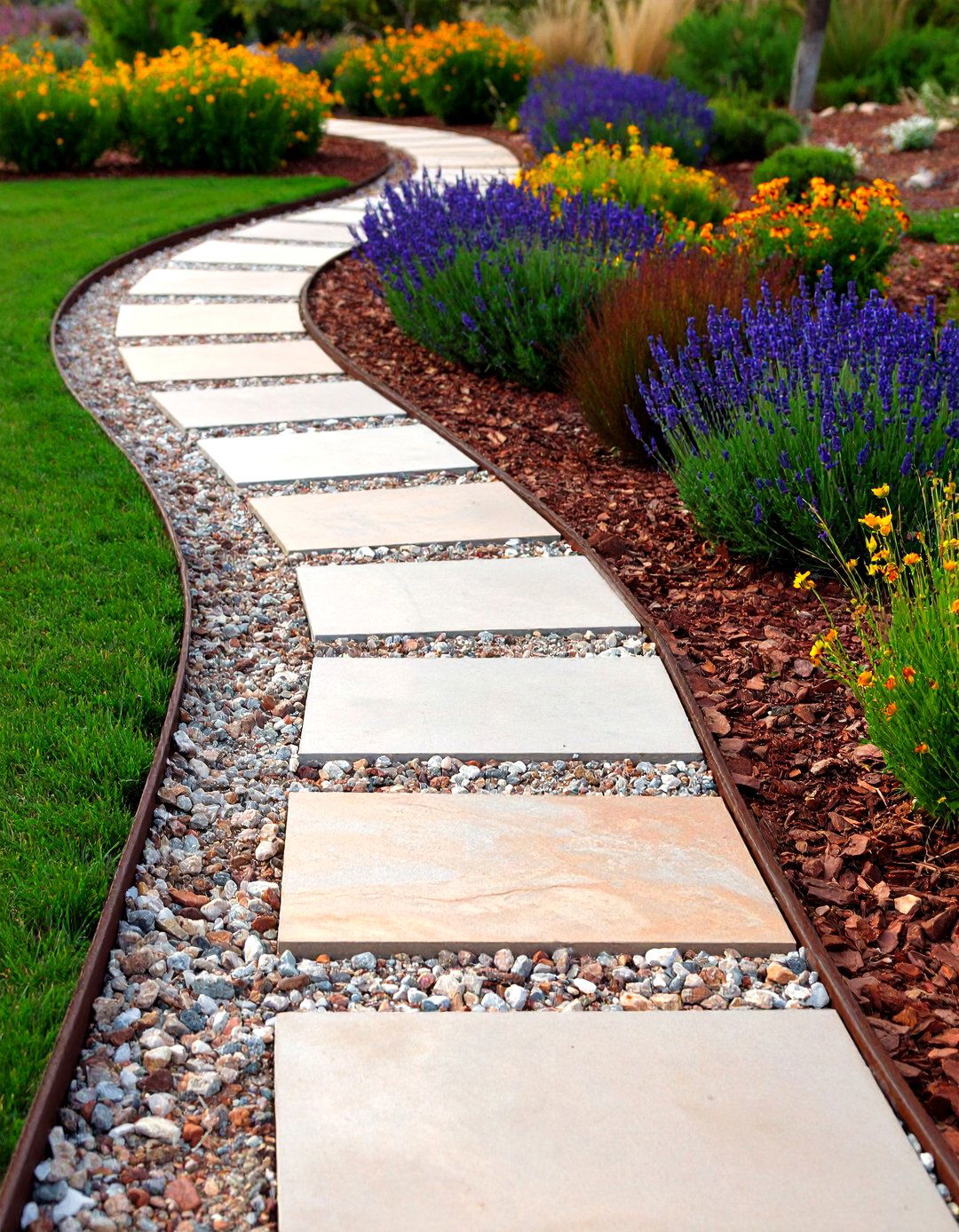
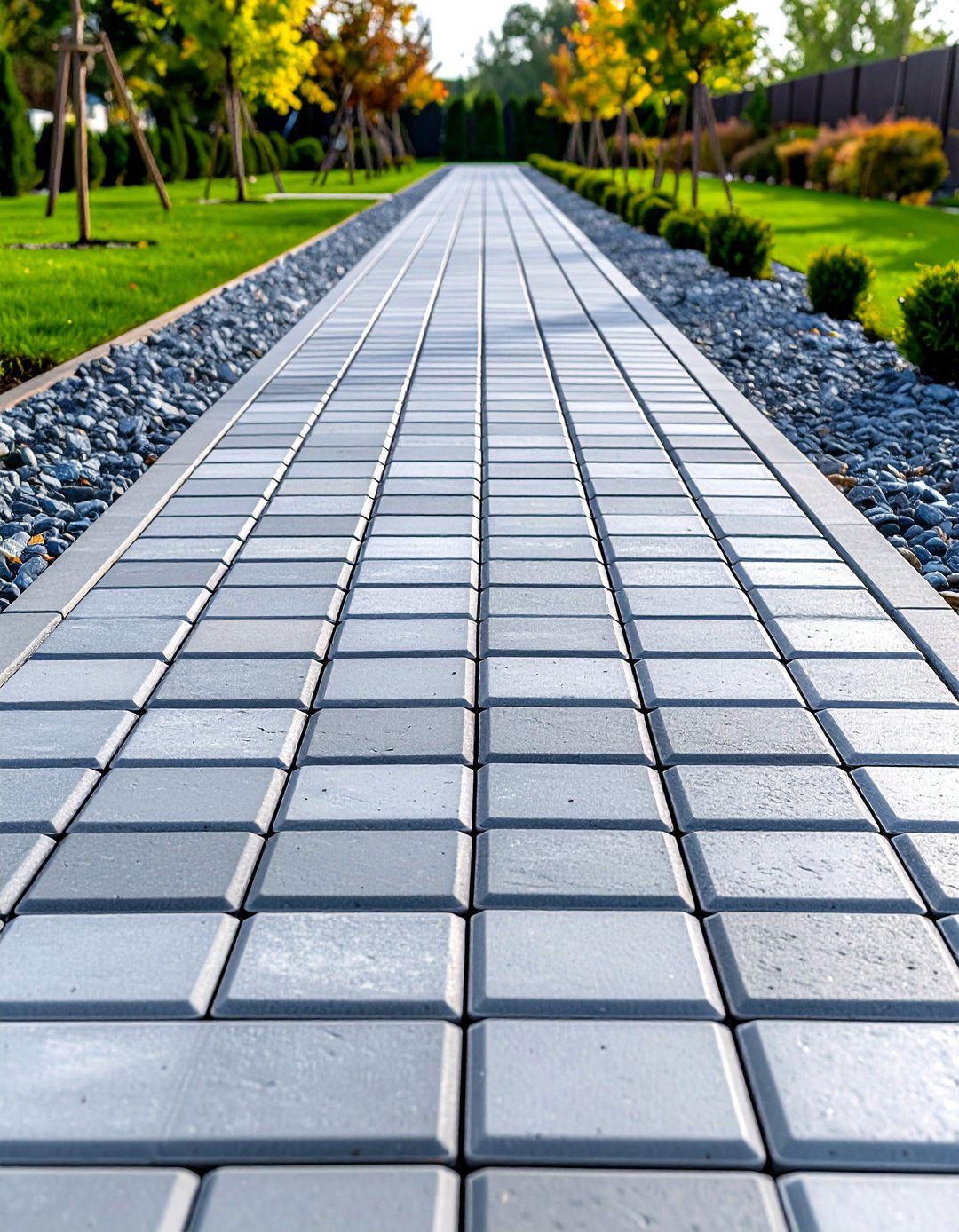

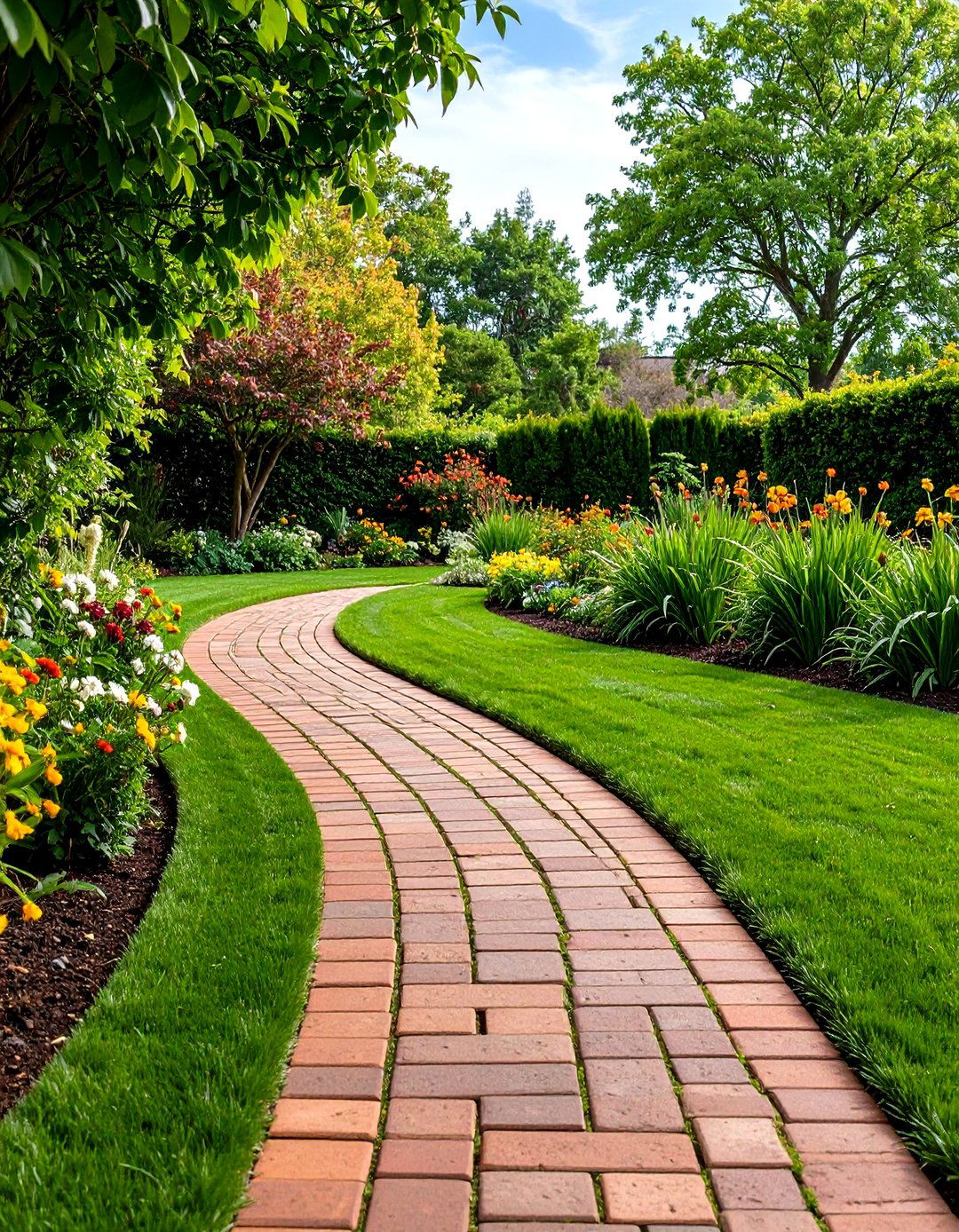

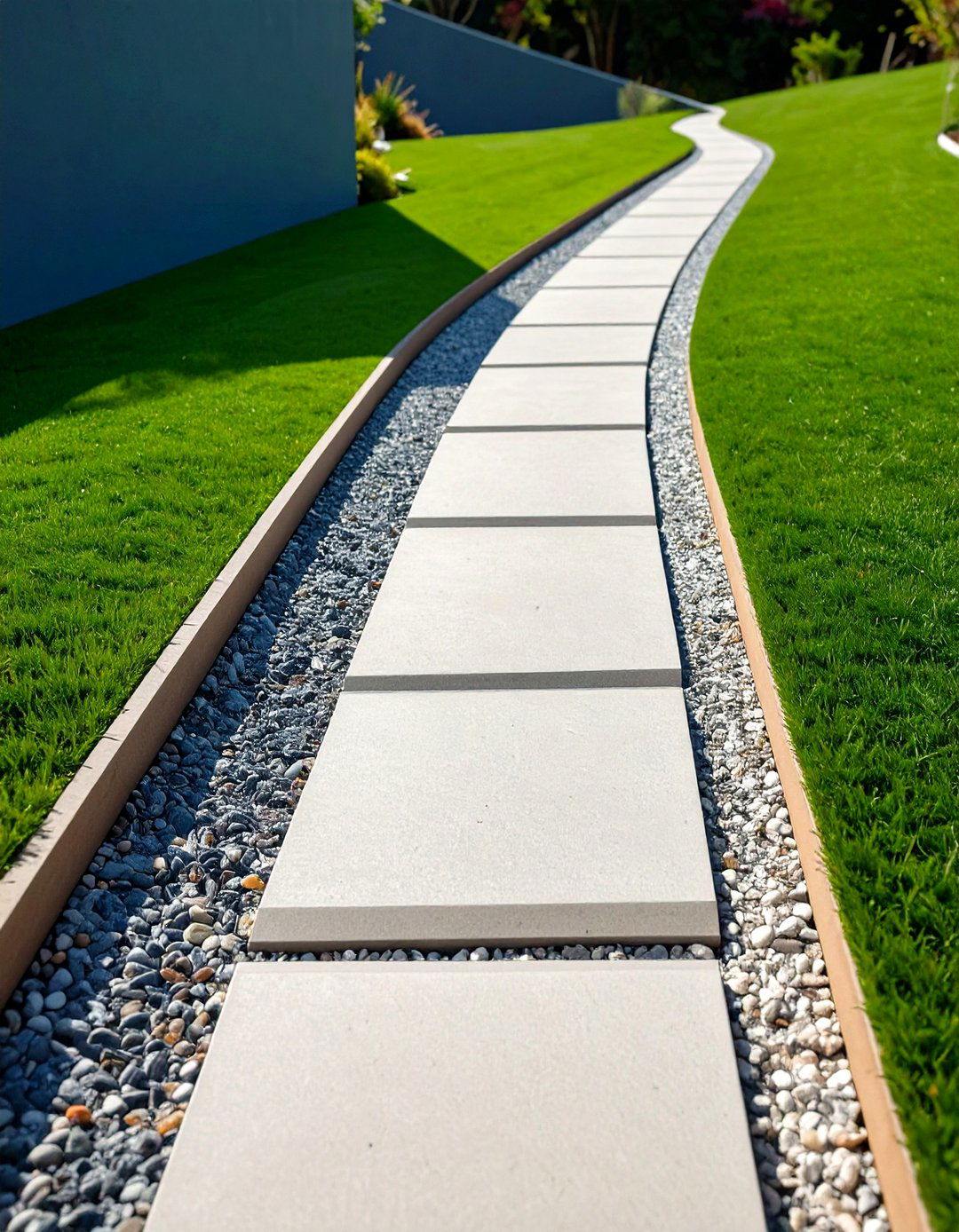
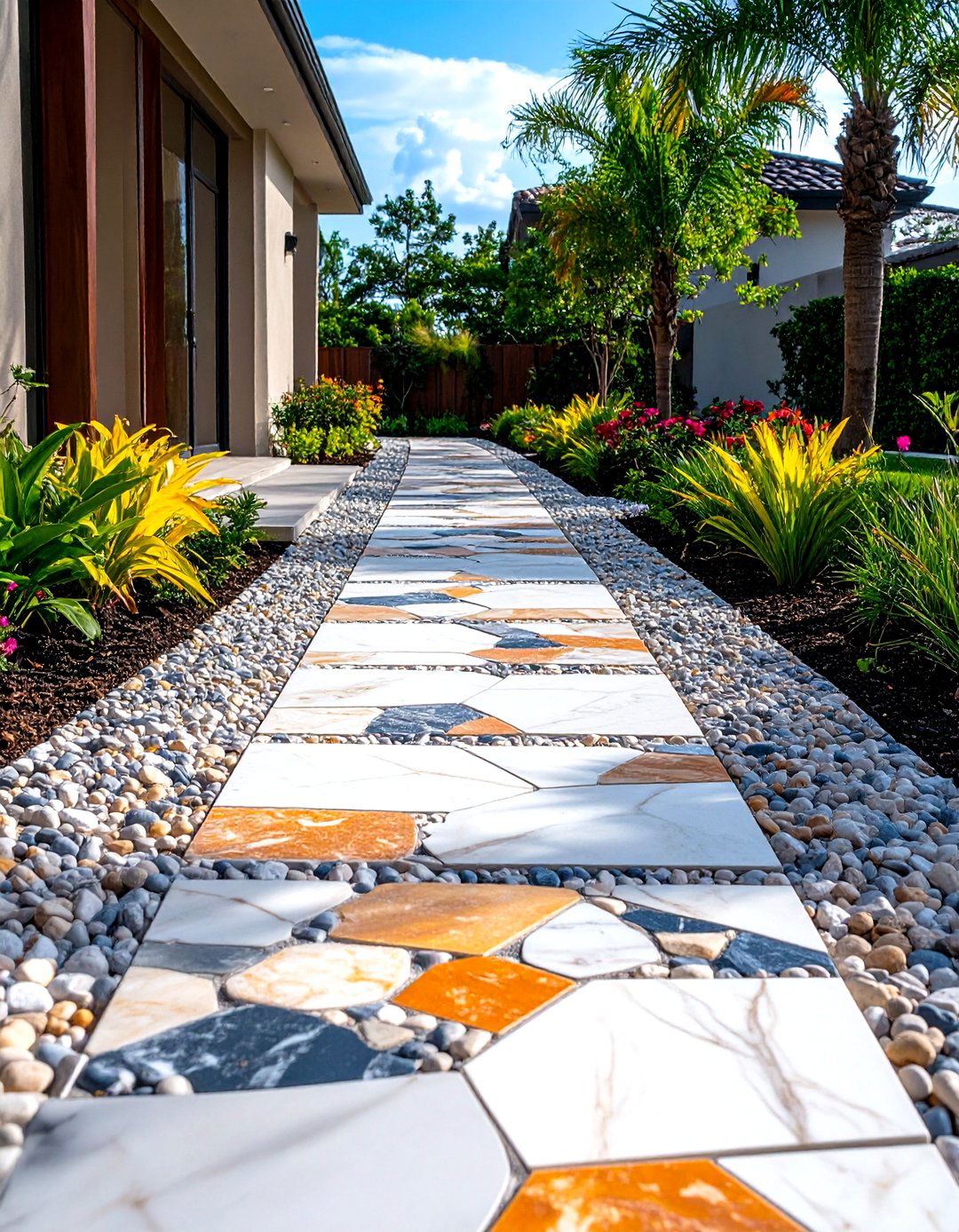
Leave a Reply